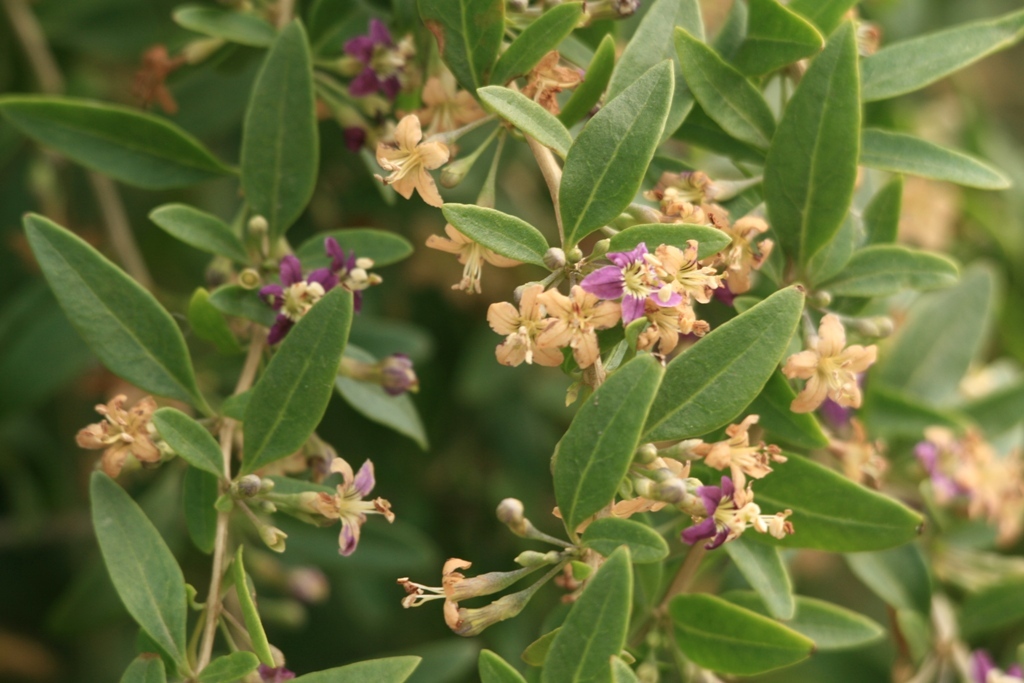
The Solanaceae or Nightshade family is a family with edible as well as poisonous members. It is therefor a fascinating one with 11 genera described in Stace of which many are neophytes.
Neophytes were introduced to these shores after the discovery of the New World in c.1550 on purpose as an ornamental or food plant. But many are also arrived accidently through wool shoddy, and in more recent years with oil-seed, bird-seed and agricultural seed.
Extract from PDF all about Wool Shoddy:
“On enquiry he found that wool waste (“shoddy”) was unloaded at the sidings and delivered to local farmers for use as a manure, and when this was followed up foreign weeds were found to be plentiful in their fields. By 1952 he had found 112 species of wool aliens in Bedfordshire (Dony, 1953) and was in touch with the firms near Bradford that despatched the “shoddy” -in that year he went to Yorkshire and in Bradford, Morley, Heckmondwike and Kirkheaton found over 40 species.”
The Wild Flower Key describes just the 5 best-known species in the Nightshade Family:
- Lycium barbarum or Duke of Argyll’s Teaplant
- Datura stramonium or Thorn-apple
- Hyoscyamus niger or Henbane
- Solanum dulcamara or Bittersweet
- Solanum nigrum or Black Nightshade
- Atropa belladonna or Deadly Nightshade
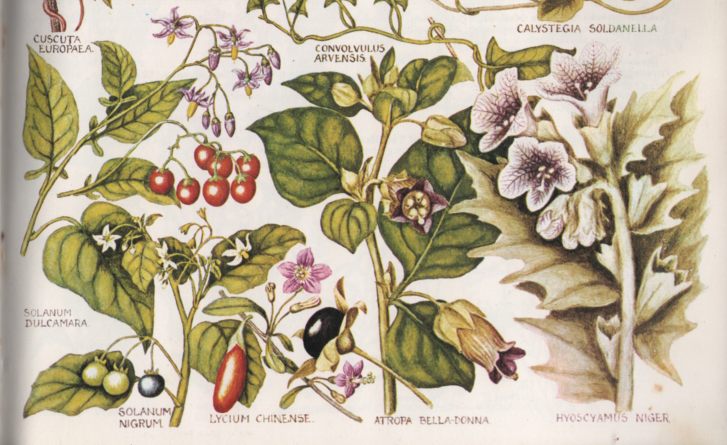
Pictures with gratitude from Mike Poulton, Matt Summers and Wikipedia Commons. FBBC added behind the common name below in the contents when the plant is described in the Flora of Birmingham and the Black Country.
Warning:
Please note that this is an educational blog and not a guide for medicinal use. All plants in this family are poisonous!! Many poisonous plants are however also often employed as medicine in a much reduced amount of course.
Contents
Lycium barbarum or Duke of Argyll’s Teaplant FBBC
- L. chinense or Chinese Teaplant FBBC
Atropa belladonna or Deadly Nightshade FBBC
Hyoscyamus niger or Henbane FBBC
Nicandra physalodes or Apple-of-Peru FBBC
Datura stramonium or Thorn-apple FBBC
- D. ferox or Longspine Thorn-apple FBBC
Salpichroa origanifolia or Cock’s-eggs FBBC
Alkekengi officinarum or Japanese-lantern FBBC
- P. peruviana or Cape-gooseberry FBBC
- P. ixocarpa or Tomatillo
- P. philadelphica or Large-flowered Tomatillo
- P. pubescens
- P. angulata
Capsicum annuum or Sweet Pepper
Solanum spp
- Solanum nigrum or Black Nightshade FBBC and
- Ssp. nigrum + Ssp. schultesii
- S. villosum or Red Nightshade
- S. scabrum or Garden Huckleberry
- S. chenopodioides or Tall Nightshade
S. nitidibaccatum (syn S. physalifolium) or Green Nightshade FBBC
- S. sarrachoides or Leafy-fruited Nightshade
- S. triflorum or Small Nightshade
S. dulcamara or Bittersweet FBBC
- S. tuberosum or Potato FBBC
- S. lycopersicum or Tomato FBBC
- S. laciniatum or Kangaroo-apple
- S. carolinense or Horse-nettle
- S. sisymbrifolium or Red Buffulo-bur
S. rostratum or Buffulo-bur FBBC
- S. chacoense or Chaco Potato and locally known as ‘Jack Hawkes’ Potato FBBC
- S. nitidibaccatum
- S. pseudocapsicum
Nicotiana rustica or Wild Tobacco
- N. sylvestris or Argentine Tobacco FBBC
- N. tabacum or Tobacco
- N. alba or Sweet Tobacco
- N. x sanderea or Garden Tobacco FBBC
- N. forgetiana or Red Tobacco
Petunia x hybrida or Petunia FBBC
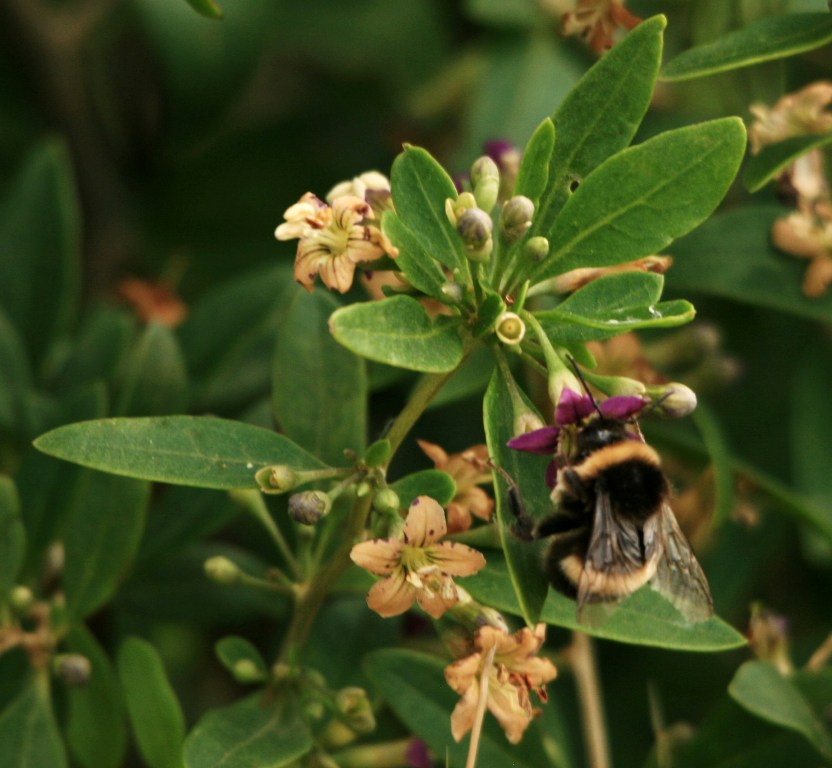
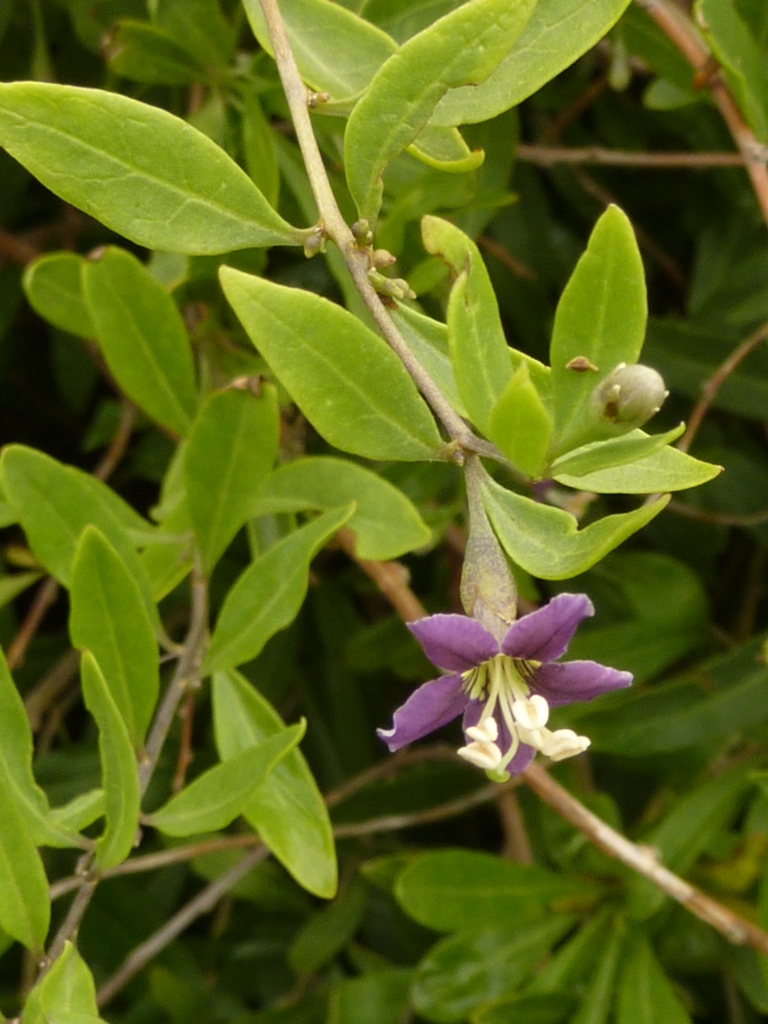
Lycium barbarum or Duke of Argyll’s Teaplant (by Matt Summers)
Lycium barbarum or Duke of Argyll’s Teaplant FBBC
The two species of Lycium in the British Isles (L. barbarum and L. chinense) are deciduous shrubs, spreading vegetatively by tip-rooting of the arching stems or by suckering. They are found most often planted in hedges bounding gardens from where they often escape if left untended, also occasionally bird-sown or established from dumped material on waste land, refuse tips, shingle, riverbanks, hedgebanks and walls.
Lycium barbarum had been introduced in the 1730s by The Duke of Argyll, but the plant was mostly used for hedges, especially in coastal districts as well as for decorative gardening.
Its red berries are attractive to a wide variety of British birds.
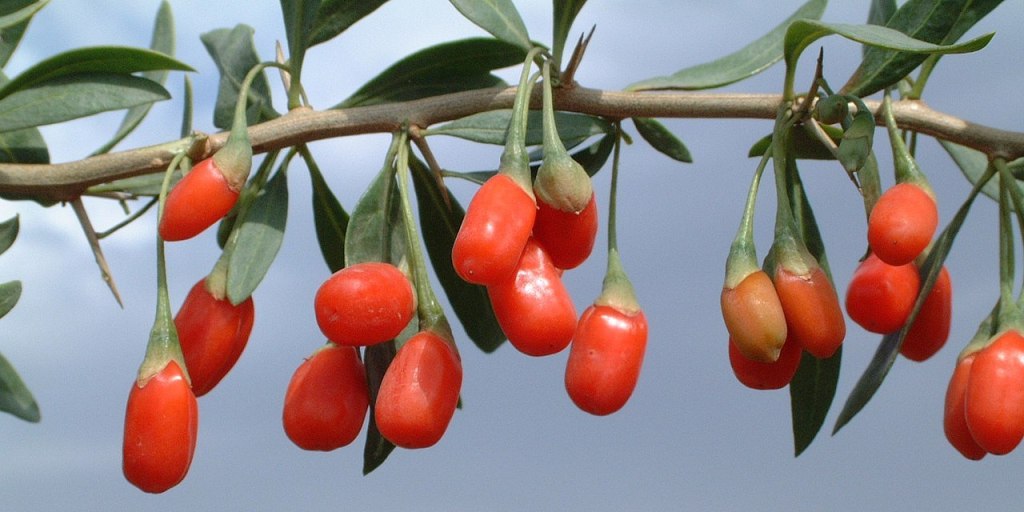
Importation of mature Lycium barbarum plants into the United Kingdom from most countries outside Europe is illegal, due to the possibility they could be vectors of diseases attacking Solanaceae crops, such as potato or tomato.
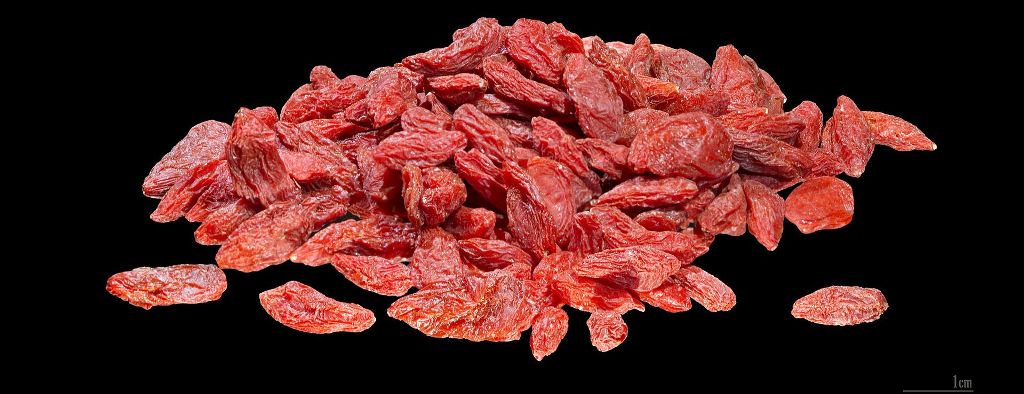
Dried Goji berries (by Didier Descouens in Wikipedia)
Goji, goji berry, or wolfberry is the fruit of either Lycium barbarum or Lycium chinense, two closely related species of boxthorn in the nightshade family, Solanaceae. L. barbarum and L. chinense fruits are similar but can be distinguished by differences in taste and sugar content.
- Both of these species are native to Asia and have been long used in traditional Asian cuisine.
- Young wolfberry shoots and leaves are harvested commercially as a leaf vegetable.
- The berries are used in dishes as either a garnish or a source of sweetness.
- The fruits may be infused with hot water to make goji tea.
The fruit has also been an ingredient in traditional Chinese, Korean, and Japanese medicine since at least the 3rd century AD. In pharmacopeias, the fruit of the plant is called by the Latin name lycii fructus and the leaves are called herba lycii.
Since about 2000, goji berry and derived products have become common in developed countries as health foods or alternative medicine remedies, extending from exaggerated and unproven claims about their health benefits.
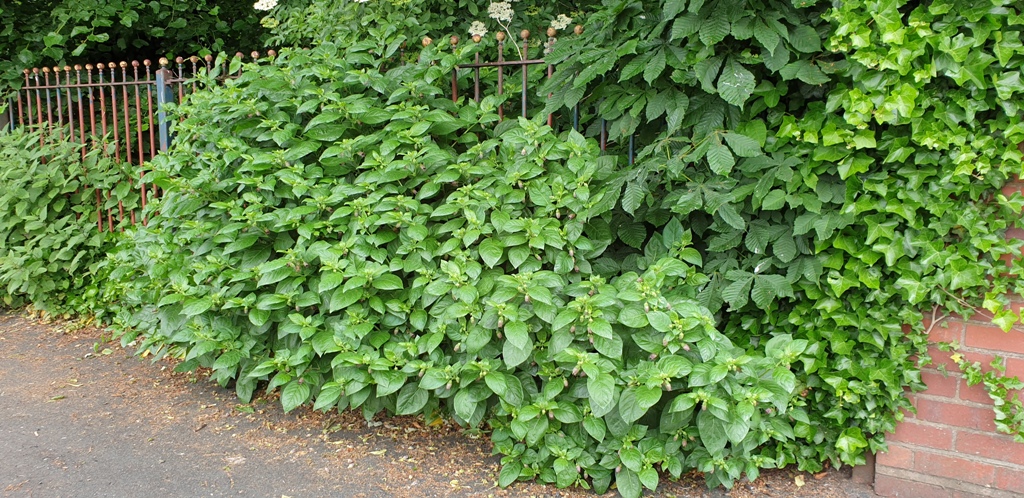
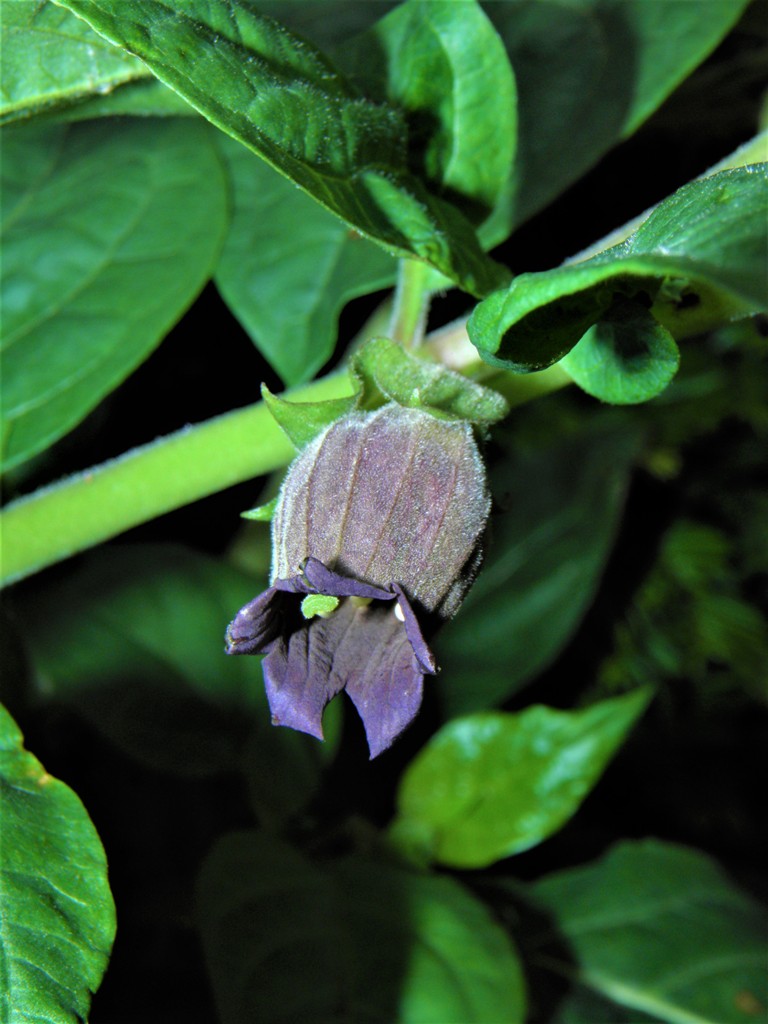
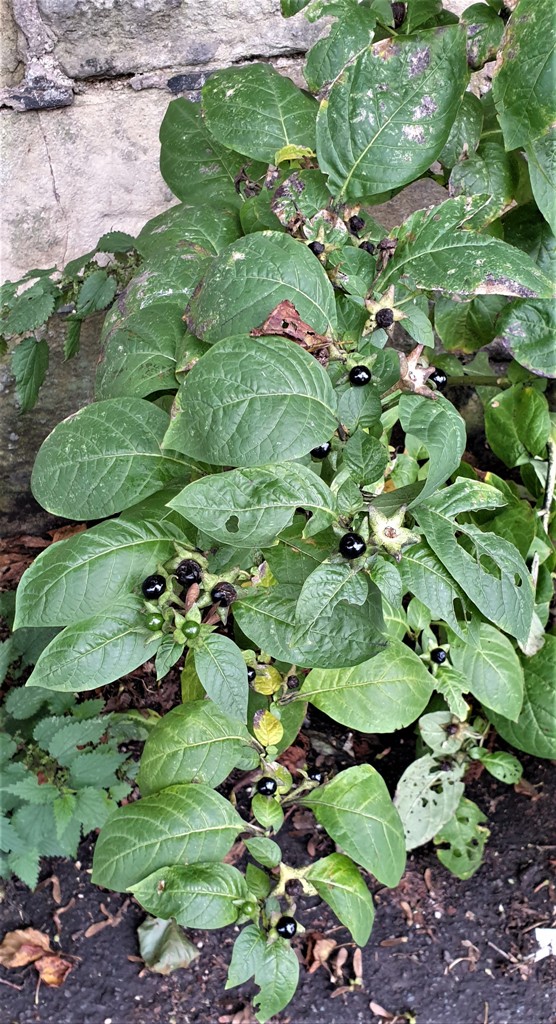
Atropa belladonna or Deadly Nightshade FBBC
A robust rhizomatous perennial herb of dry disturbed ground, field margins, grassland, hedgerows and open woodland. It is native only on calcareous soils, particularly those overlying chalk and limestone, but it occurs on a wider range of soils as an alien, where it is often a relic of cultivation as a medicinal herb. Dispersal is mainly by bird-distributed seed.
Native in Britain and a neophyte in Ireland and the Channel Islands.
The name Atropa belladonna was published by Carl Linnaeus in Species Plantarum in 1753. Atropa is derived from the name of the Greek goddess Atropos (‘she who may not be turned aside’ i.e. ‘the inflexible’ or ‘the implacable’)—one of the three Greek fates or destinies who would determine the course of a man’s life by the weaving of threads that symbolized his birth, the events in his life, and finally his death, with Atropos cutting these threads to mark the last of these. The name “belladonna” comes from the Italian language, meaning ‘beautiful lady’; originating either from its usage as a cosmetic to beautify pallid skin, or more probably, from its usage to increase the pupil size in women.
Belladonna is one of the most toxic plants known, and can be deadly as is part of its name! All parts of the plant contain tropane alkaloids.
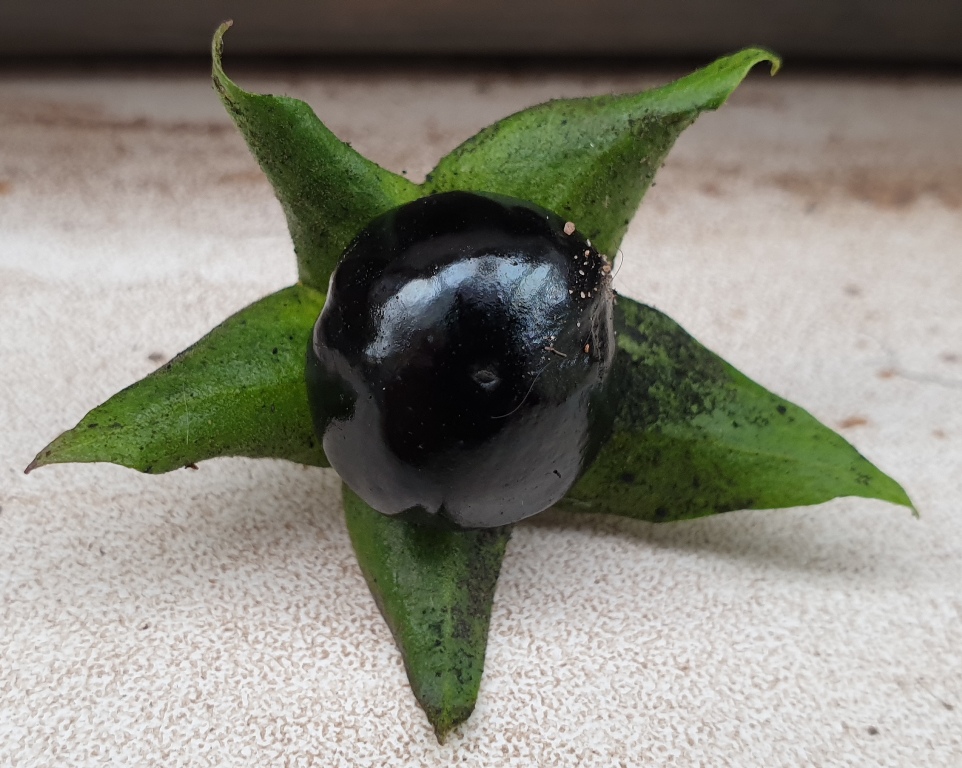
Although Deadly nightshade has been used in herbal medicine for centuries as a pain reliever, muscle relaxer, and anti-inflammatory, and to treat menstrual problems, peptic ulcer disease, histaminic reaction, and motion sickness, it is unise to administer this most poisenous herb in any form!!
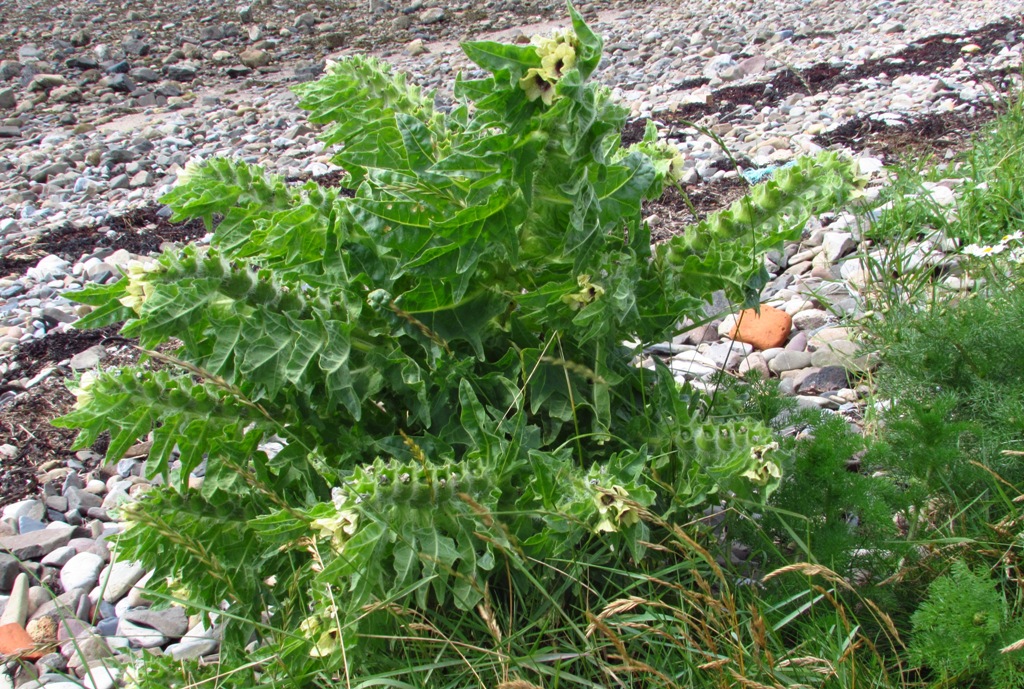
Hyoscyamus niger or Henbane FBBC
An annual to biennial herb, found in a wide variety of disturbed habitats including arable field margins, tracks and roadsides, sand dunes, open areas in calcareous grassland, refuse tips, old sand- and gravel-pits and waste ground. It prefers disturbed ground, including rabbit warrens, badger setts and building sites, mostly on calcareous or other free-draining soils, particularly those overlying chalk. Although usually casual, it is often sporadic in occurrence, sometimes emerging in large numbers, suggesting that it forms a long-term persistent seed bank. It is occasionally introduced in seed mixtures amongst legume crops and on newly sown verges.
Henbane was historically used in combination with other plants, such as mandrake, deadly nightshade, and datura, as an anaesthetic potion, as well as for its psychoactive properties in “magic brews”.
All parts of the plant are very toxic to humans and to cattle, wild animals, fish, and birds.
But not all animals are susceptible; for example, the larvae of some Lepidoptera species, including cabbage moths, eat henbane. Pigs are immune to henbane toxicity and are reported to enjoy the effects of the plant.
Like many poisenous plants: Henbane is used in traditional herbal medicine for ailments of the bones, rheumatism, toothache, asthma, cough, nervous diseases, and stomach pain. It might also be used as analgesic, sedative, and narcotic in some cultures. Adhesive bandages with henbane extract behind the ear are reported to prevent discomfort in travel-sick people. Henbane oil is used for medicinal massage.
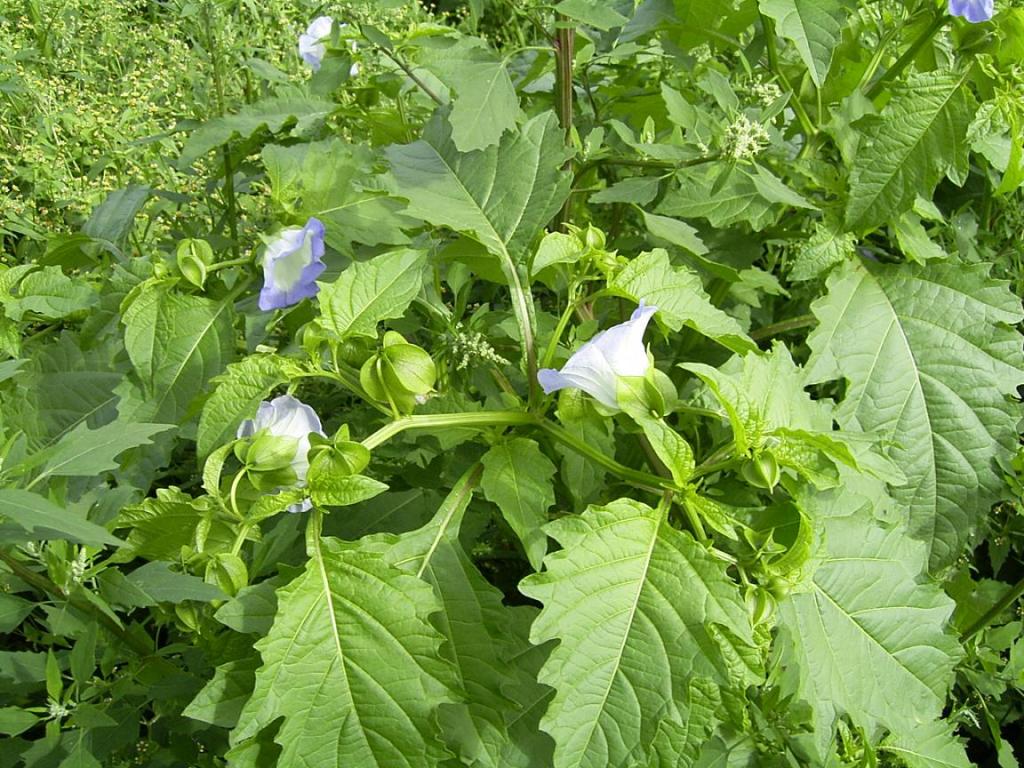
Nicandra physalodes or Apple-of-Peru and Shoo-fly plant FBBC
A large annual herb, occasionally grown as an ornamental in gardens but also arising from birdseed. Usually occurring as a casual in gardens and allotments, on refuse tips, on disturbed ground and on soil and manure heaps. It seeds can overwinter, resulting in established populations in milder areas, some apparently self-sowing (especially in allotments and gardens).
N. physalodes was grown in Britain by 1759 and it was first recorded in the wild in 1850 (Isle of Wight). Its size and appearance mean that it is unlikely to be overlooked and its distribution has increased dramatically since the 1960s.
The shoo-fly plant is an annual that is sometimes grown from seed to add interest to borders. However, as occasional seedlings may appear in the garden (such as from bird-sown seed or seed fallen from a bird feeder), it is sometimes thought of as a weed.
The literature on the plant features somewhat conflicting accounts of use, as a species both edible and toxic/medicinal, pointing to the conclusion that it should be regarded as suspect and treated with caution. The whole plant is said to be toxic (even, according to some sources, very toxic) but is also used medicinally as a diuretic, sedative and cough medicine.
The tender leaves have, on occasion, been cooked as a leaf vegetable or pot herb (e.g. in the cuisine of Tanzania), yet the decoction of the leaves has been used as an insecticide to treat head lice; while the juice of the fresh leaves has been used to treat amoebiasis.
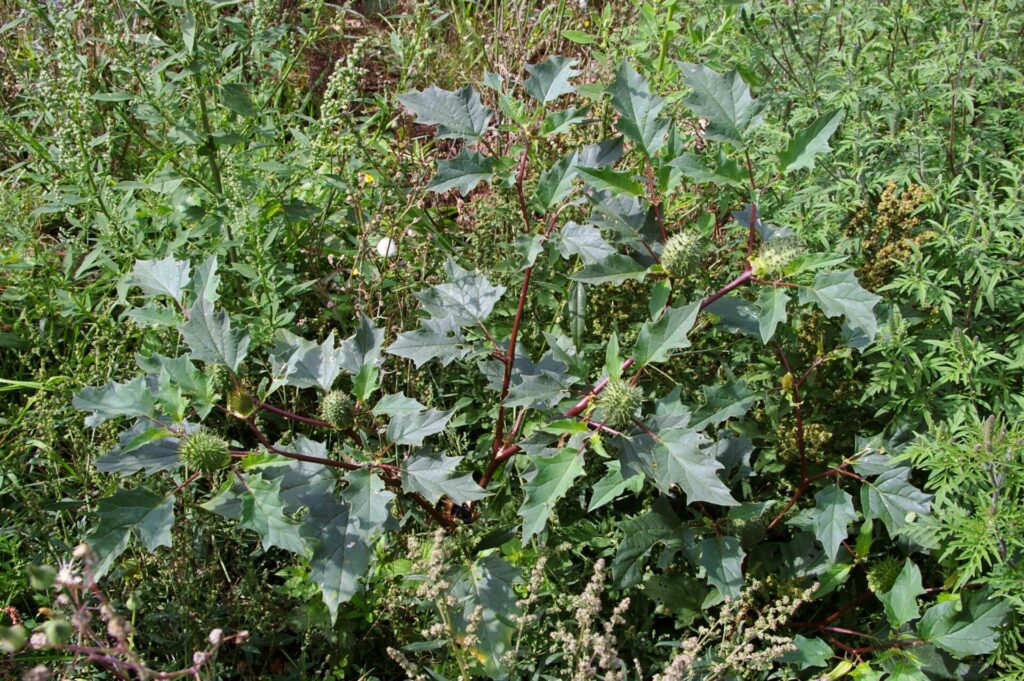
Datura stramonium or Thorn-apple FBBC
An annual herb of waste ground, refuse tips, cultivated and disturbed ground. Most populations are casual, but the species can become naturalized, or reappear after long periods from dormant seeds. It most frequently arises from birdseed, but also from oil-seed and grain.
D. stramonium was cultivated in Britain by 1596 and was grown commercially for alkaloids used to treat asthma. It was first recorded in the wild in 1690. As a casual at many locations, changes within its range are difficult to assess, with much turnover apparent. However, new records this century have extended the species’ range into Ireland and into northern Scotland, with a first record for Orkney in 2006.
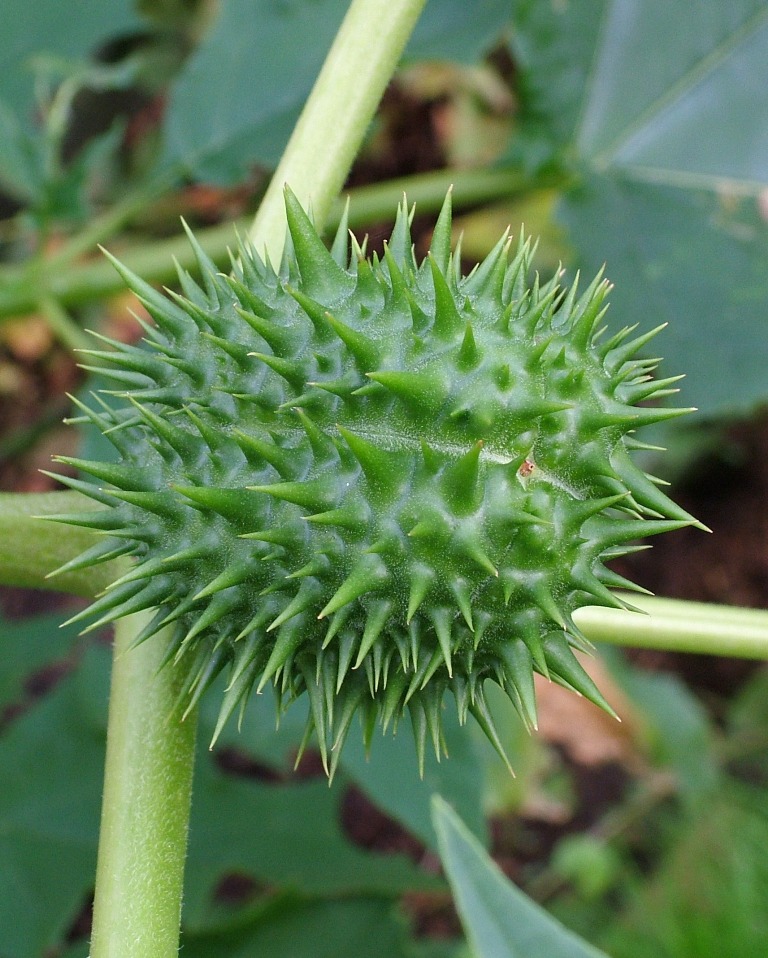
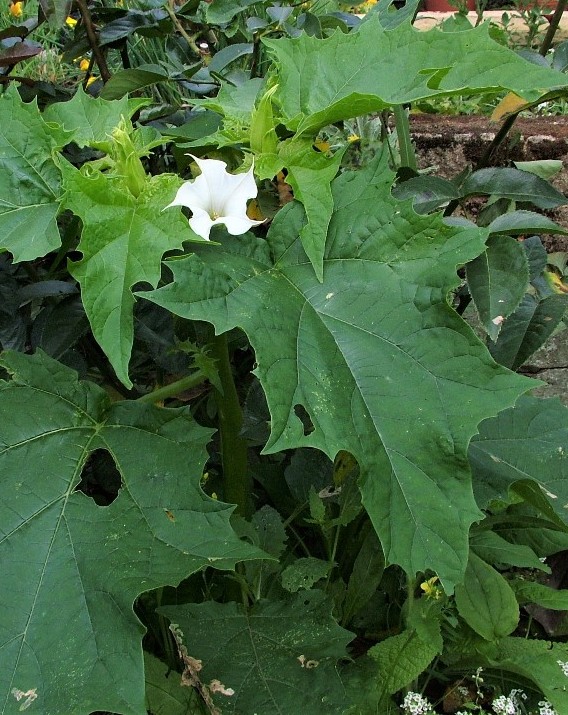
Fruit and plant with flower (by Mike Poulton)
All parts of Datura plants contain dangerous levels of the tropane alkaloids, atropine, hyoscyamine, and scopolamine, which are classified as deliriants, or anticholinergics. The risk of fatal overdose is high among uninformed users, and many hospitalizations occur among recreational users who ingest the plant for its psychoactive effects. Deliberate or inadvertent poisoning resulting from smoking jimsonweed and other related species has been reported.
Across the Americas, indigenous peoples, such as the Algonquian, Aztecs, Navajo, Cherokee, Luiseño and the indigenous peoples of Marie-Galante used this plant or other Datura species in sacred ceremonies for its hallucinogenic properties.
In Ethiopia, some students and debtrawoch (lay priests), use D. stramonium to “open the mind” to be more receptive to learning, and creative and imaginative thinking.
In European witchcraft, D. stramonium was also a common ingredient used for making witches’ flying ointment along with other poisonous plants of the nightshade family. It was often responsible for the hallucinogenic effects of magical or lycanthropic salves and potions. During the witch-phobia craze in Early Modern times in England and parts of the colonial north eastern United States it was often considered unlucky or inappropriate to grow the plant in one’s garden as it was considered to be an aid to incantations.
Muscarinic antagonists, found in the tribe Datureae (among other plants), such as atropine, and synthetic tropane derivatives selective for muscarinic acetylcholine receptor subtypes such as ipratropium bromide and tiotropium bromide, are prescribed in some cases of chronic obstructive pulmonary disease and asthma.
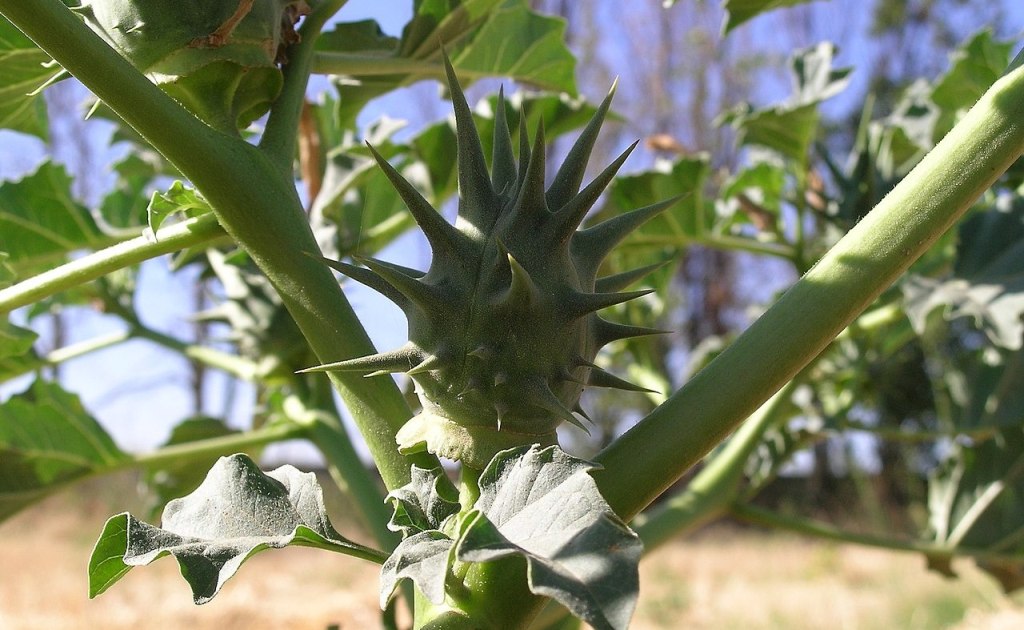
- D. ferox or Longspine Thorn-apple FBBC
An annual herb, found as a casual on arable fields and refuse tips originating as a grain impurity, and formerly from wool shoddy. It is also occasionally grown in gardens, from which most recent records probably originate.
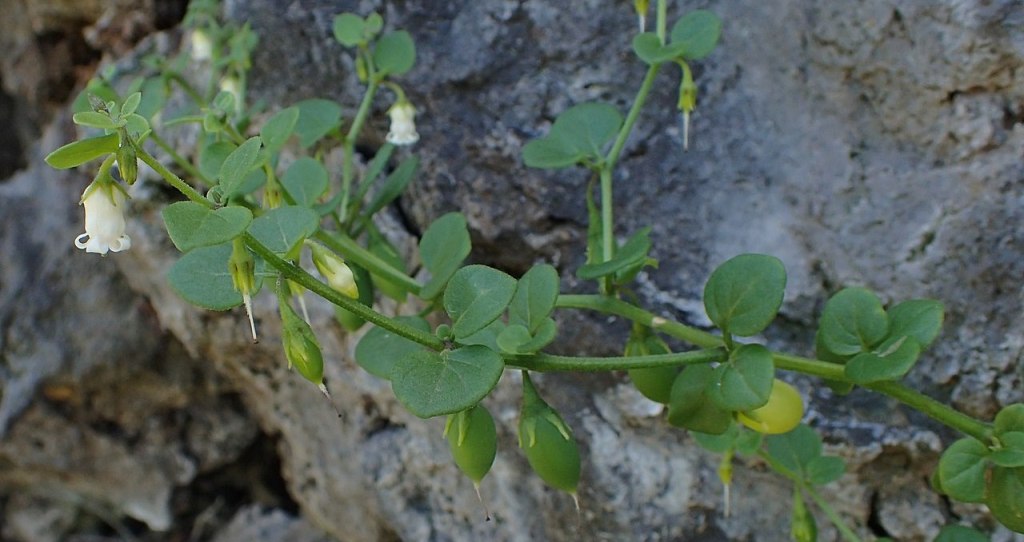
Salpichroa origanifolia or Cock’s-eggs FBBC
A sprawling, perennial, rhizomatous herb with a woody base, naturalized or as a casual on cliffs, in rough grassland, on road verges and in waste places. Reproduction is by seed, and some populations can be large and long-lived. It arises as a garden escape.
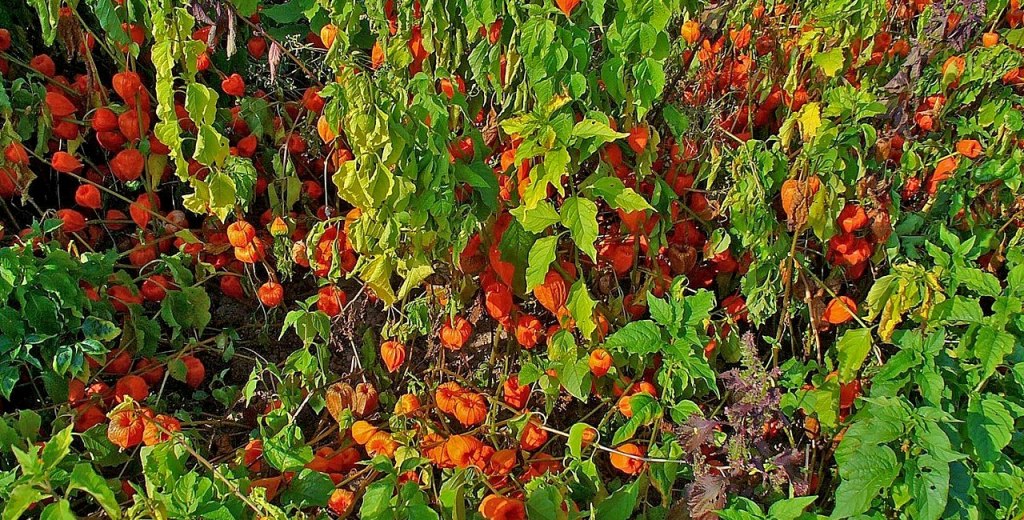
Alkekengi officinarum or Japanese-lantern FBBC
A perennial herb, grown in gardens and allotments for its bright orange calyces, but with long rhizomes that can lead to it being thrown-out. It has been found on waste ground and refuse tips, on roadside verges, railway banks and other waste places. Most records are of established colonies; dispersal by seed is limited and the majority of populations are probably derived from garden throw-outs. It is very persistent when established.
It is a popular ornamental, herbaceous plant, widely cultivated in temperate regions of the world, It can be invasive with its wide-spreading root system sending up new shoots some distance from where it was originally planted.
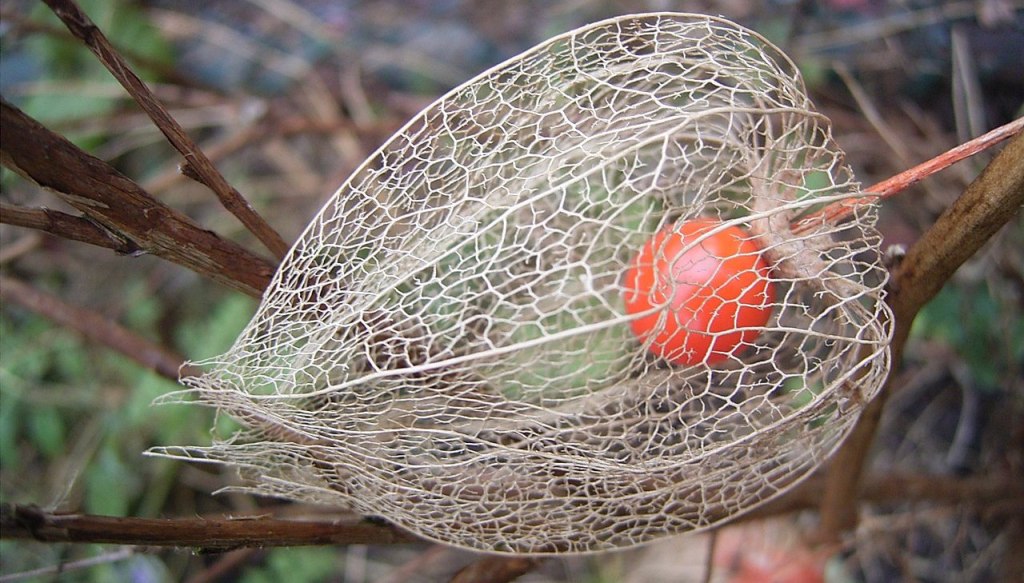
In the United Kingdom it has been given the Royal Horticultural Society‘s Award of Garden Merit.
All parts of the plant, except the ripe fruit, are poisonous
The dried fruit is called the golden flower in the Unani system of medicine, and used as a diuretic, antiseptic, liver corrective, and sedative.
In Chinese medicine, Alkekengi is used to treat such conditions as abscesses, coughs, fevers, and sore throat.
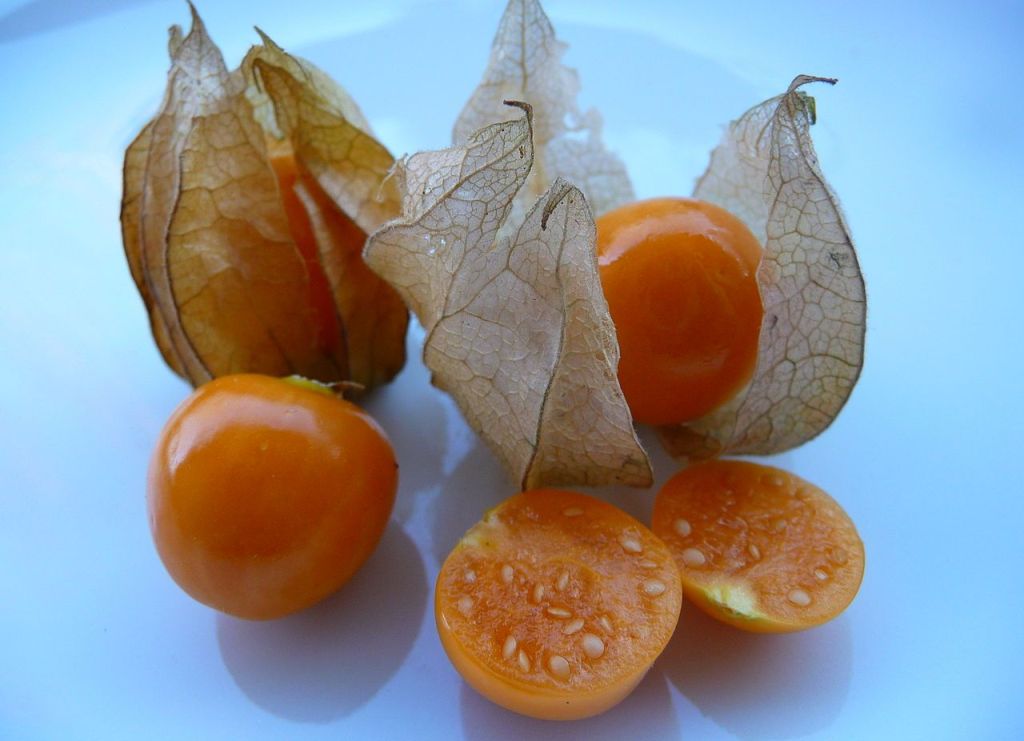
- Physalis peruviana or Cape-gooseberry FBBC
A rhizomatous perennial herb which occurs on refuse tips and waste ground. It is usually casual but a few populations in southern England are naturalized. It arises from birdseed, oil-seed and from food refuse, and formerly from wool shoddy.
The fruit is a round, smooth berry, resembling a miniature yellow tomato. Removed from its calyx, it is bright yellow to orange in color, and sweet when ripe, with a characteristic, mildly tart grape-like flavor.
The fruit is rich in vitamin A (3000 I.U. of carotene per 100g), vitamin C and some of the B complex (thiamine, niacin and B12). The protein and phosphorus levels are exceptionally high for a fruit. The fruit is a berry about 2cm in diameter. The dried fruit is said to be a substitute for yeast. If picked carefully with the calyx intact, the fruit can be stored for 3 months or more.
The leaf juice has been used in the treatment of worms and bowel complaints. The plant is diuretic.
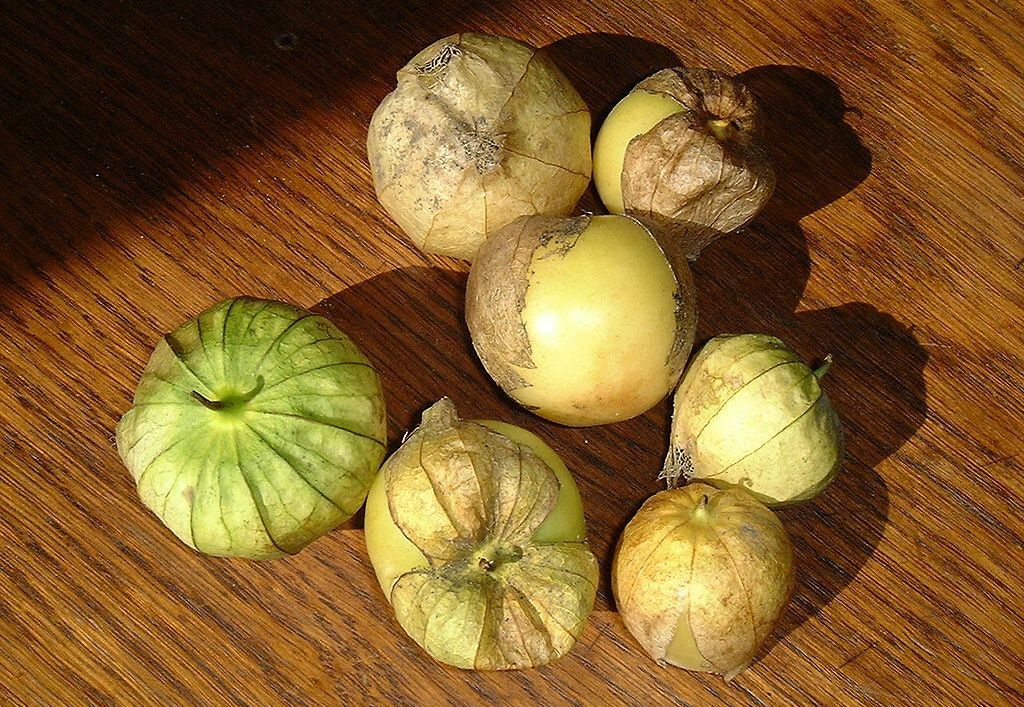
A perennial herb, but usually grown here as an annual, which occurs in fields and waste places, arising mostly from wool shoddy in the past. Rarely, its fruit is eaten and some plants may arise from this source, and from bird-seed.
Tomatillos are a key ingredient in fresh and cooked Mexican and Central-American green sauces. The green color and tart flavor are the main culinary contributions of the fruit.
Tomatillos can be harvested at different stages of ripeness. For salsa verde, harvesting may be done early when the fruit is sour with a light flavor. Tomatillos can be picked later when the fruits are seedier for a sweeter taste. Tomatillos have diverse uses in stews, soups, salads, curries, stirfries, baking, cooking with meats, marmalade, and desserts.
- P. philadelphica or Large-flowered Tomatillo
- P. pubescens or Hairy Groundcherry
- P. angulata or Angular Winter Cherry
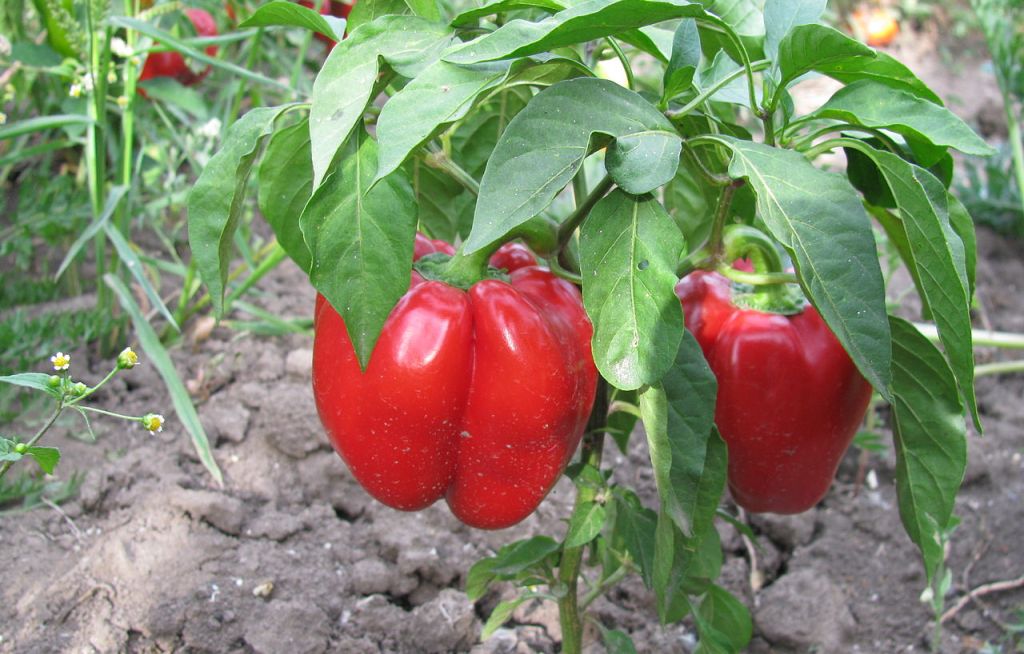
Capsicum annuum or Sweet Pepper
An annual herb, occasionally grown in gardens, and found as a casual on refuse tips, in sewage works, in gardens and on waste ground, where it arises from food-refuse and bird-seed.
Capsicum annuum is a species of the plant genus Capsicum native to southern North America, the Caribbean, and northern South America. This species is the most common and extensively cultivated of the five domesticated capsicums. The species encompasses a wide variety of shapes and sizes of peppers, including sweet bell peppers and some chili pepper varieties such as jalapeños, New Mexico chile, and cayenne peppers.
Solanum spp
Solanum is a large and diverse genus of flowering plants, which include three food crops of high economic importance: the potato, the tomato and the aubergine (eggplant, or brinjal). It is the largest genus in the nightshade family Solanaceae, comprising around 1,500 species.
There are also several species grown on the B.I. as ornamental house or garden plant.
Native or Neophyte members are:
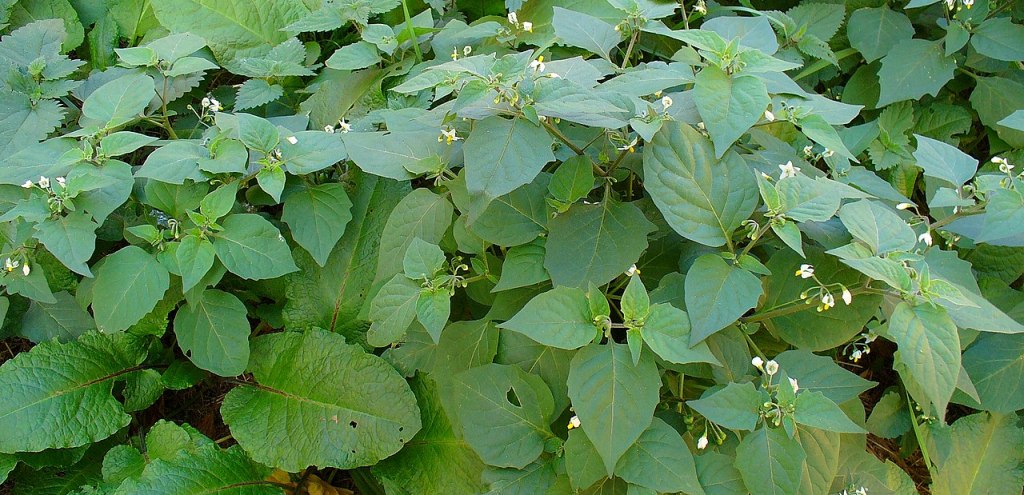
An annual herb of cultivated and waste ground, especially where the soil is nutrient-rich. On Colonsay (South Ebudes) subsp. schultesii occurs along strandlines at the top of beaches. Usually lowland, but reaching 480 m at Eisteddfa Gurig (Cardiganshire).
Native or alien in Britain and the Channel Islands and a neophyte in Ireland.
Solanine poisoning symptoms occur when immature green fruit (looks similar to green peas) or mature leaves are ingested raw.
There are ethnobotanical accounts of S. nigrum young leaves and shoots being boiled as a vegetable with the cooking water being discarded and replaced several times to remove toxins. Solanine is water-soluble and is destroyed by boiling. S. nigrum leaves may be different from this perspective. Young cooked leaves of Solanum complex sp. are a source many useful nutrients similar to levels found in spinach. Solanum complex berries have been consumed on every continent since ancient times.
It was a traditional European medicine used as a strong sudorific, analgesic and sedative with powerful narcotic properties, but was considered a “somewhat dangerous remedy”, Internal use has fallen out of favour in western herbalism due to its variable chemistry and toxicity, but it is used topically as a treatment for herpes zoster.
There is much disagreement as to whether the leaves and fruit of S. nigrum are poisonous. But many countries grow this plant as a food crop. The toxicity of S. nigrum may vary by the region and species where it grows. Native Hawaiians use the berries’ juice as a laxative, they also take the young leaves boiled to relieve sore throats and coughs.
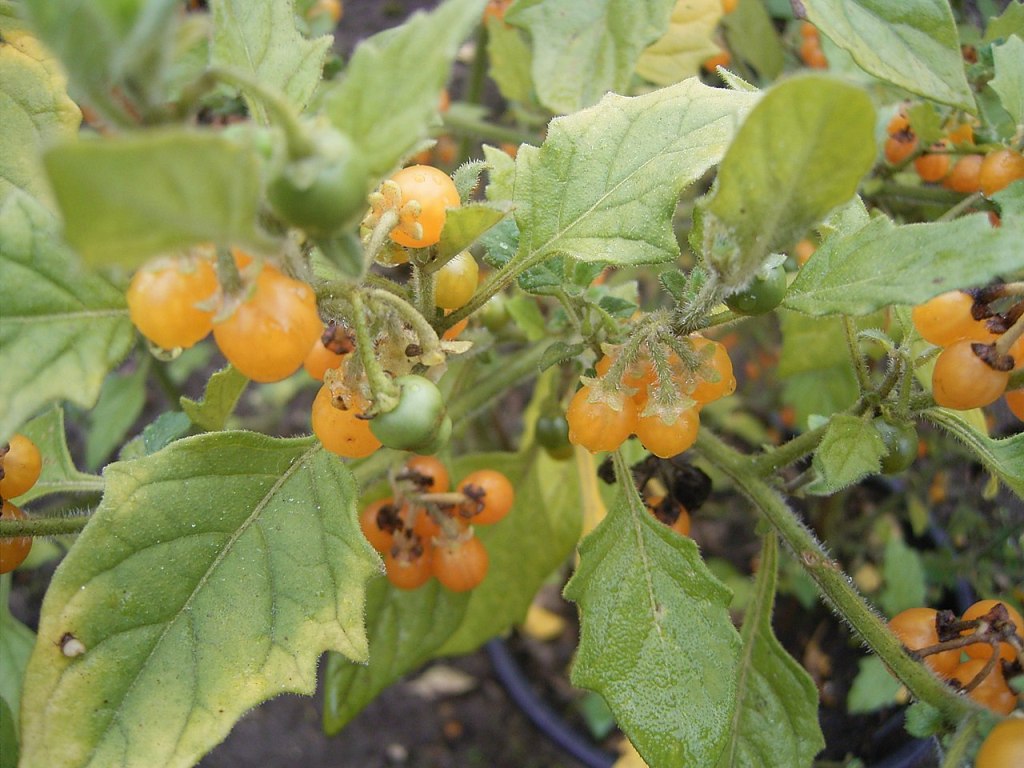
An annual herb, found in fields and other cultivated land, and on refuse tips and waste ground. It formerly arose from wool shoddy, but is now introduced with bird-seed and oil-seed.
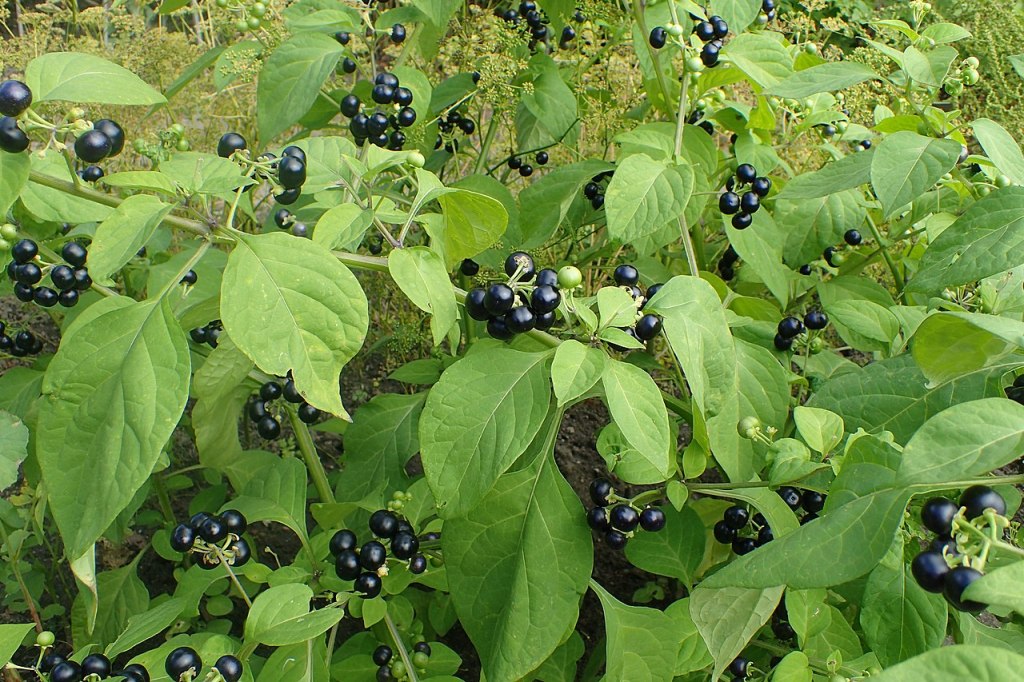
An annual herb, found as a casual on refuse tips, sewage farms and waste ground, where it arises as a garden escape and from food refuse. It also occurs in fields spread with sewage sludge. Most populations are casual but is has been recorded as naturalized in Hertfordshire.
There is a lot of disagreement over whether or not the leaves or fruit of this plant are poisonous. Views vary from relatively poisonous to perfectly safe to eat. The plant is cultivated as a food crop, both for its fruit and its leaves, in some parts of the world and it is probably true to say that toxicity can vary considerably according to where the plant is grown and the cultivar that is being grown. The unripe fruit contains the highest concentration of toxins.
- Ripe (!) Fruit – cooked and used in preserves, jams and pies. Often cooked with some baking soda first in order to remove any bitterness.
- Young leaves and new shoots – raw or cooked as a potherb or added to soups.
- The whole plant is antiperiodic, antiphlogistic, diaphoretic, diuretic, emollient, febrifuge, narcotic, purgative and sedative.
- The leaves, stems and roots are used in the treatment of cancerous sores, leucoderma and wounds.
- Extracts of the plant are analgesic, antispasmodic, anti-inflammatory and vasodilator.
- The plant has been used in the manufacture of locally analgesic ointments and the juice of the fruit has been used as an analgesic for toothaches.
A perennial herb, found on pavements, waste ground and in rough grassland. It is naturalised in the Channel Islands and the London area, but is a rare casual elsewhere.
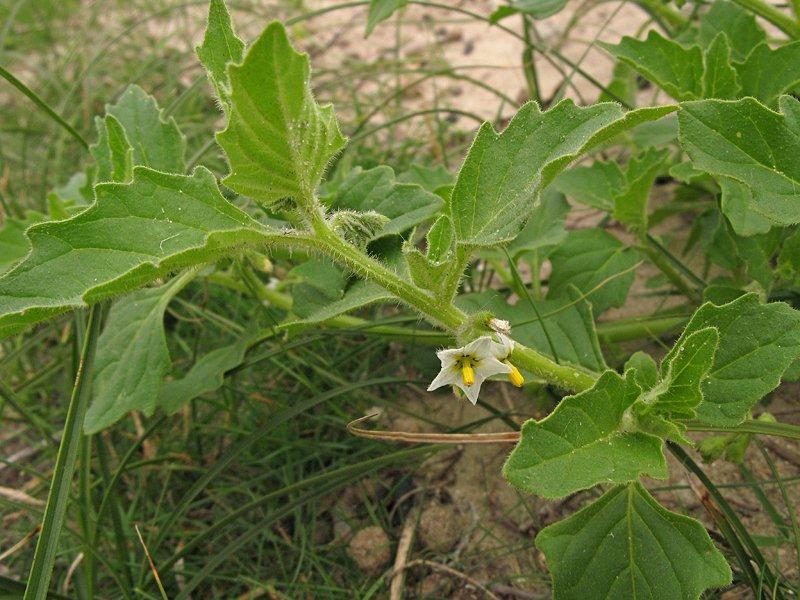
S. nitidibaccatum (syn S. physalifolium) or Green Nightshade FBBC
An annual herb, found as an arable weed, as well as in abandoned fields, on waste land and refuse tips. The majority of populations are casual, but the species can occasionally become established.
An erect or decumbent annual herb, found as a casual on cultivated ground, refuse tips and waste ground. Rarely, it becomes naturalized.
An annual herb, found in cultivated fields, rough ground and waste ground. It is naturalized in West Norfolk, West Suffolk and Cheviot, but is casual elsewhere. It originally arose from wool shoddy but now occurs as a contaminant of agricultural seed.
Fruit can be eaten raw or cooked as a fruit or vegetable. It can also be dried, ground into a powder and used with cereals for making bread etc. The ripe fruit can be boiled, mashed and mixed with ground chilli and salt then used as a condiment with mush or bread.
A decoction of the berries has been used in the treatment of stomach aches and for children with diarrhoea.
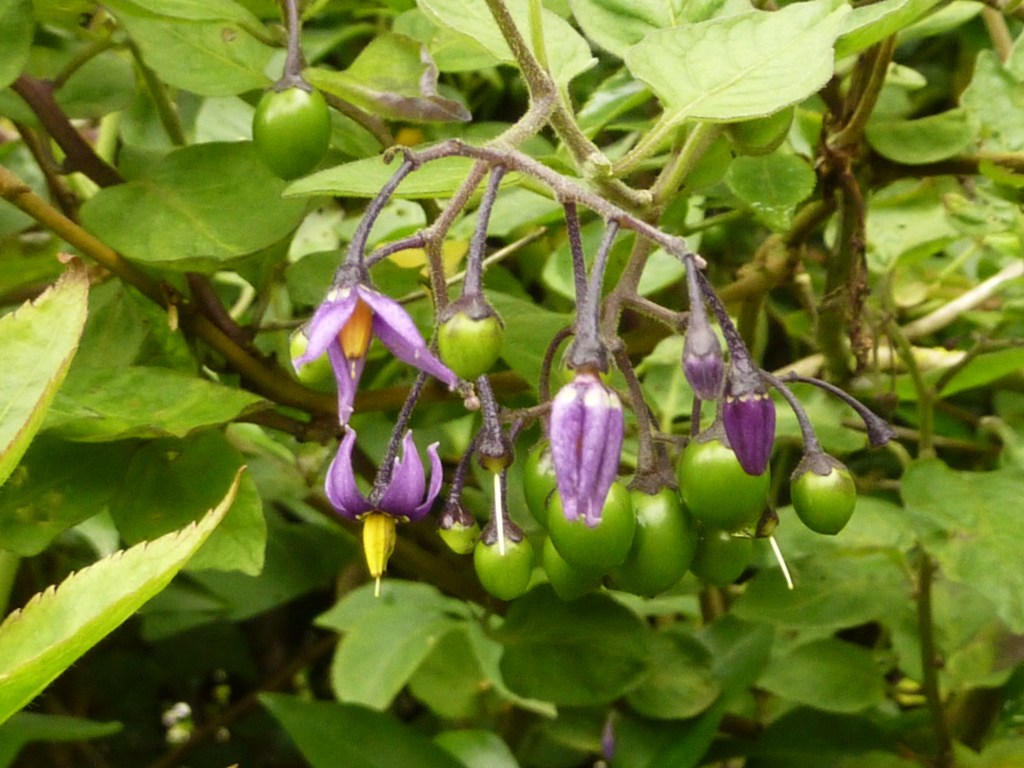
Flowers and Berries of S. dulcamara or Bittersweet (pictures by Matt Summers)
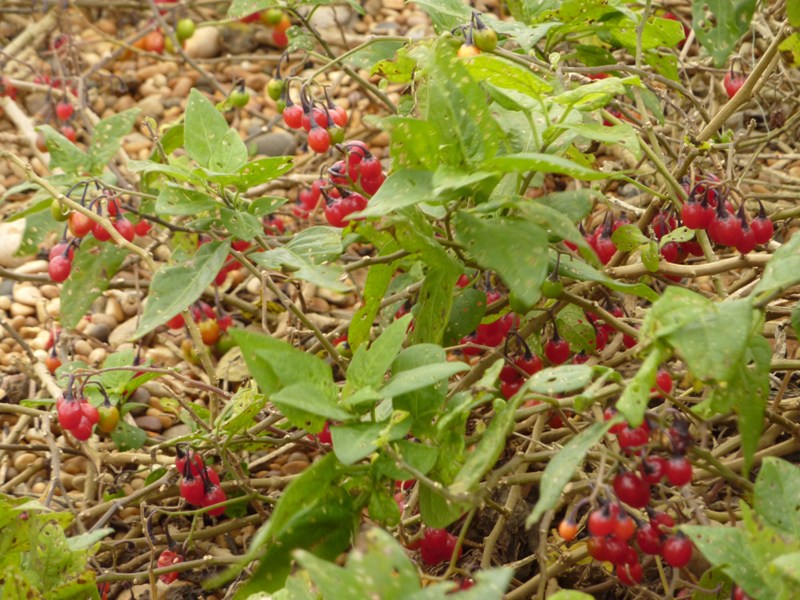
S. dulcamara or Bittersweet FBBC
Probably our most common native member of the Solanaceae. The Common names include Bittersweet, Bittersweet nightshade, Bitter Nightshade, Blue Bindweed, Amara Dulcis, Climbing Nightshade, Felonwort, Felonwood, Poisonberry, Poisonflower, Scarlet Berry, Snakeberry, Trailing Bittersweet, Trailing Nightshade, Violet Bloom, and Woody Nightshade. (!! source: Wikipedia)
A scrambling, woody perennial of woodland, thickets, hedgerows, ditches and, as var. marinum, on shingle beaches. It often grows in moist habitats and is common in swamps and tall-herb fens and beside rivers and lakes, where it can even grow in shallow water.
This plant is one of the less poisonous members of the Solanaceae. Instances of poisoning in humans are very rare on account of the fruit’s intensely bitter taste. Incidentally, the fruit has been reported to have a sweet aftertaste, hence the vernacular name bittersweet.
S. dulcamare has a variety of documented medicinal uses, all of which are advised to be approached with proper caution as the entirety of the plant is considered to be poisonous. The bare stems have been used to treat mild recurrent eczema, psoriasis, scabies, and dermatomycosis. The leaves have been known to treat warts and tumors, while the fruit can treat conditions of the respiratory tract and joints. It has been documented that Indigenous people of North America used the roots for relief of fever and nausea.
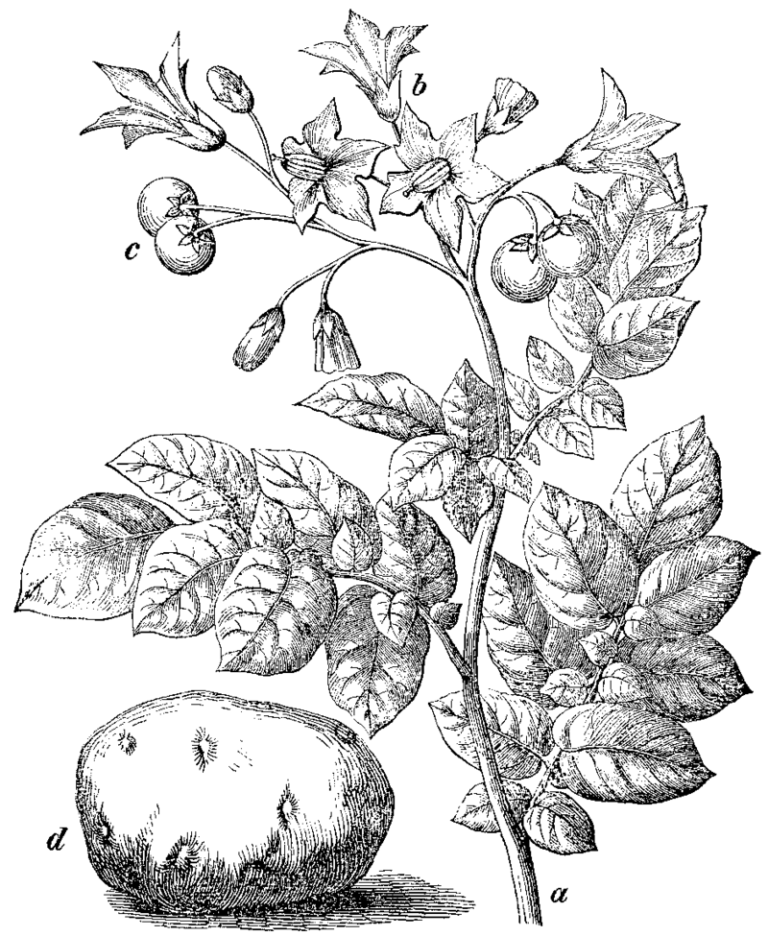
- S. tuberosum or Potato FBBC
A rhizomatous perennial herb, widely cultivated for its edible tubers, found on dumped soil, refuse tips, waste land, and on coastal sand and shingle where domestic waste has been dumped. In disturbed habitats it is usually casual, but the production of tubers allows some populations in more stable sites to become established.
Potatoes have been cultivated in the Andes for at least 7,000 years. S. tuberosum was introduced to England in about 1590, becoming a staple food of the poor, especially in Scotland and Ireland, by 1800.
Warning!
The vegetative and fruiting parts of the potato contain the toxin solanine which is dangerous for human consumption. Normal potato tubers that have been grown and stored properly produce glycoalkaloids in amounts small enough to be negligible for human health, but, if tubers are exposed to light they can accumulate a high enough concentration of glycoalkaloids to affect human health seriously.
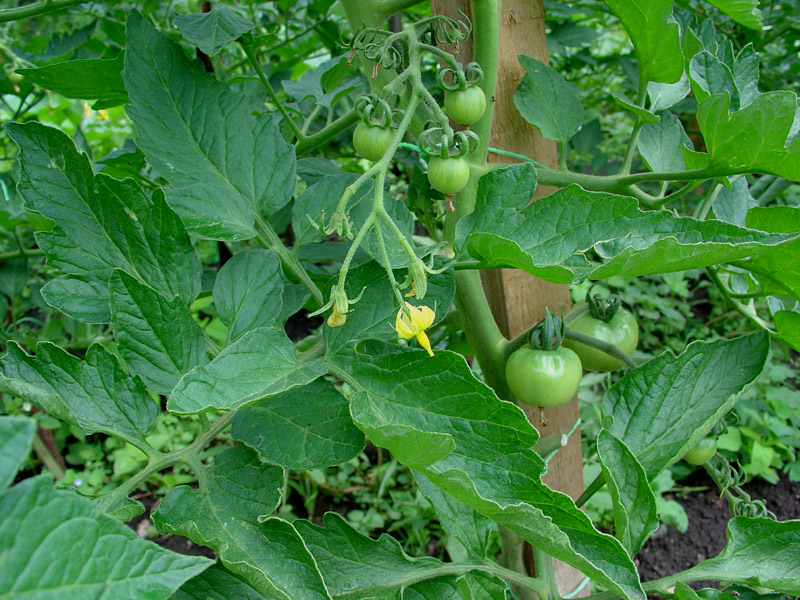
- S. lycopersicum or Tomato FBBC
A herb that is widely cultivated in gardens and allotments and found as a frequent casual on waste ground, refuse tips, railway lines, pavements and sewage works. The species behaves as a perennial in its native range, but both the plant and, to a lesser extent, its seeds are frost-sensitive. Most populations in our area are therefore killed each year, with new plants arising from seeds discarded as fresh fruit or from human sewage.
The wild ancestor of the tomato, Solanum pimpinellifolium, is native to western South America. These wild versions were the size of peas. The exact date of domestication is unknown; by 500 BC, it was already being cultivated in southern Mexico and probably other areas.
Tomatoes were being cultivated by Gerard in 1596, and are now very widely grown.
The Spanish first introduced tomatoes to Europe, where they became used in Spanish food. In France, Italy and northern Europe, the tomato was initially grown as an ornamental plant. It was regarded with suspicion as a food because botanists recognized it as a nightshade, a relative of the poisonous belladonna or deadly nightshade. This was exacerbated by the interaction of the tomato’s acidic juice with pewter plates.
The leaves and fruit contain tomatine, which in large quantities would be toxic. However, the ripe fruit contains a much lower amount of tomatine than the immature fruit.
- S. laciniatum or Kangaroo-apple
- S. carolinense or Horse-nettle
- S. sisymbrifolium or Red Buffulo-bur
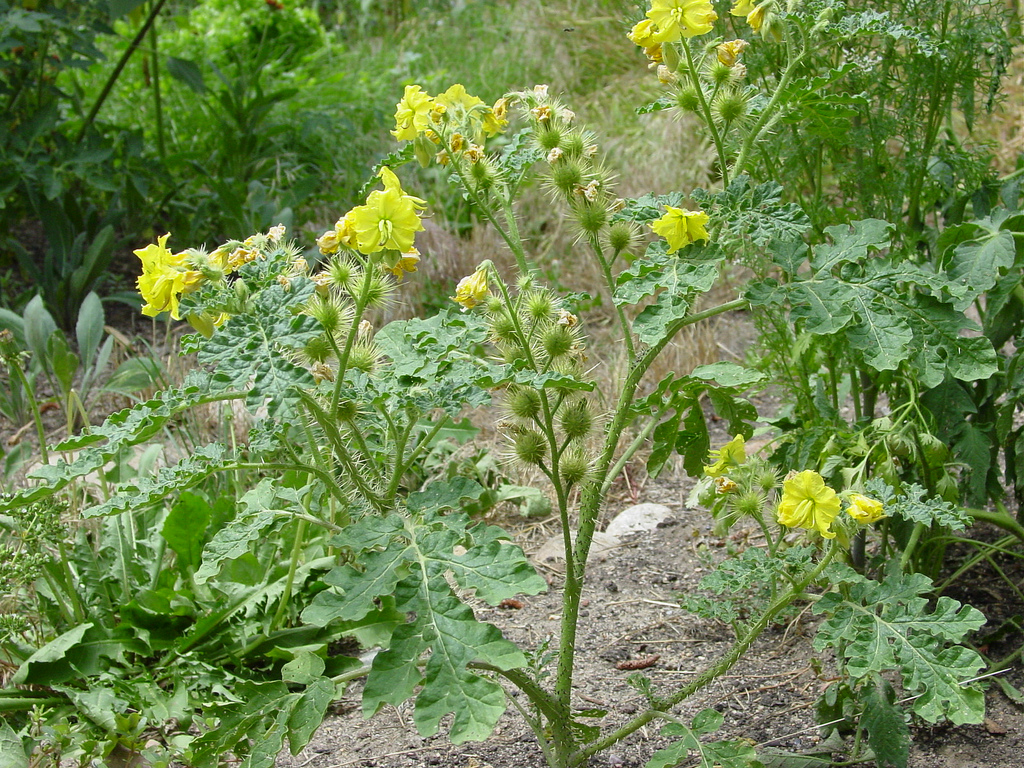
S. rostratum or Buffulo-bur FBBC
An erect annual herb, found as a casual of arable fields, refuse tips, waste places and roadsides where it is introduced with grain, birdseed, and formerly with wool shoddy.
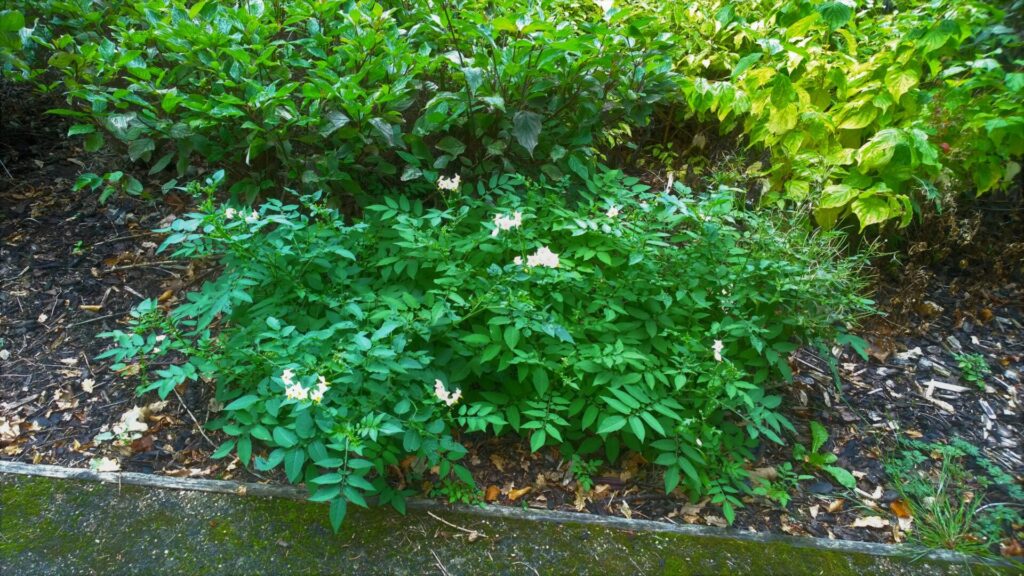
S. chacoense and locally known as ‘Jack Hawkes‘ Potato (pictures by Mike Poulton at Winterbourne Gardens, Birmingham)
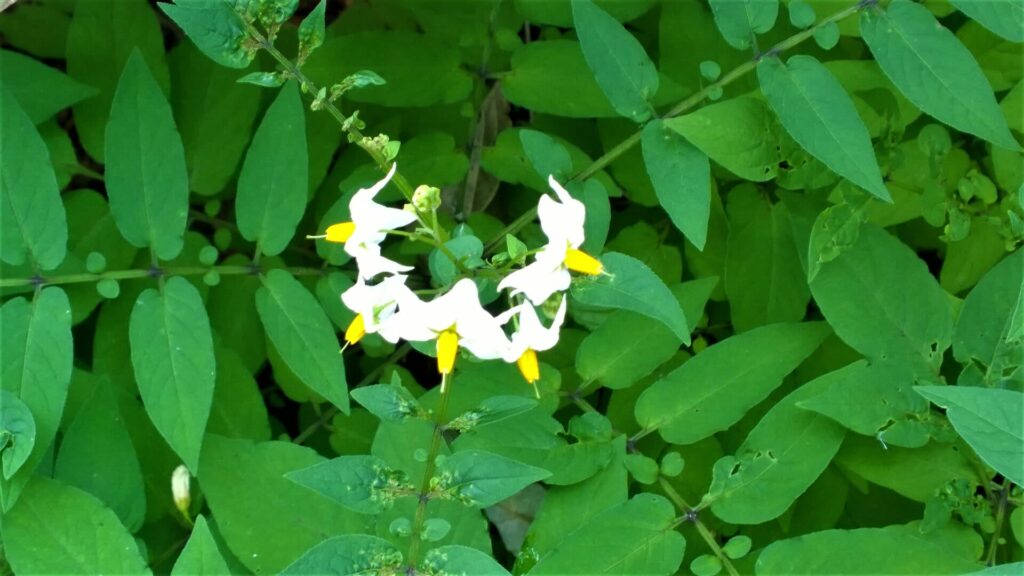
- S. chacoense or Chaco Potato and locally known as ‘Jack Hawkes‘ Potato FBBC
This is an important species of wild potato. It is native to South America, where it can be found in Brazil, Bolivia, Argentina, Peru, Uruguay, and Paraguay. It “is one of the most widely distributed wild potato species.”. It grows as a common weed in disturbed habitat such as crop fields. It can also be found in Australia, China, the United States, England, New Zealand, and elsewhere as an introduced species.
This plant has been extensively researched in the quest to find ways to improve its relative, the cultivated potato (Solanum tuberosum). It is sexually compatible with the common potato.
It was introduced to regions outside its usual range when it was imported for study and breeding with the potato.
Many of the sites where it has been found are next to plant breeding stations and botanical gardens. This wild species contains leptinglycoalkaloids which make it resistant to the Colorado potato beetle (Leptinotarsa decemlineata), a pest of potato crops. It has also shown resistance to verticillium wilt and potato leafroll virus.
This plant is locally known as ‘Jack Hawkes‘ Potato, as it was origianally cultivated and studied at University Botanic Gardens of Winterbourne, Birmingham and is still known as a weed there for at least 10 years! (From the Flora of Birmingham and the Black Country)
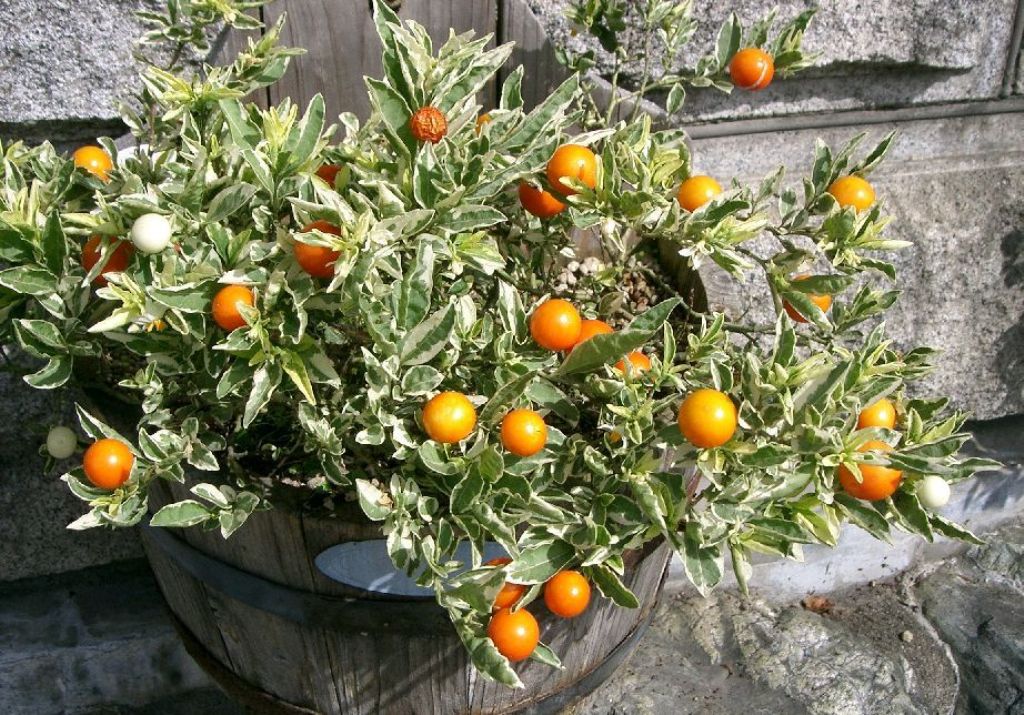
Native to Peru and Ecuador, it can survive frosts and cold weather. They generally live up to 10 years, producing fruit usually in their second or third year, and every year after that. The fruit is extremely similar to cherry tomatoes in taste and texture, and are therefore easily confused with them.
Warning!
The solanocapsin contained in the berries is toxic and is similar to solanine,. Therefore, the fruits of the Jerusalem cherry are not edible. Consumption can even cause gastrointestinal problems – such as diarrhoea, vomiting and nausea. Fortunately, the poison is not life-threatening, but it is extremely unpleasant!
It is best to keep the plant out of reach of children, because the small red berries look like cherry tomatoes and could therefore be particularly enticing to curious children.
They are attractive perennials which can often be seen around Christmas and can be grown decoratively as house plants.
In some areas of South Africa, India, Australia and New Zealand it is regarded as a weed.
Nicotiana spp. or Tobacco Plants
Annuals, biennials, perennials and shrubs with narrow, lance-shaped or broadly oval mid-green leaves, often sticky with glandular hairs. Long, tubular flowers, which open into a broad star, are borne in clusters in shades of white, pink, purple, red, yellow and green from summer into autumn. Many only open in the evening and at night, releasing a distinctive incense-like fragrance.
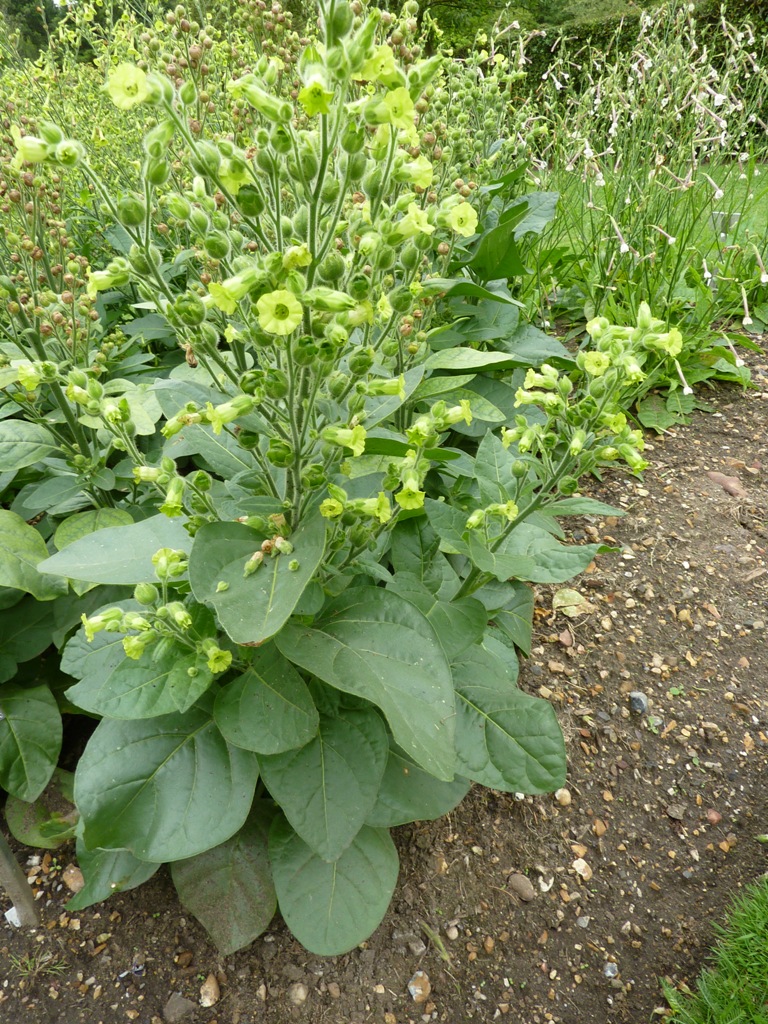
Nicotiana rustica or Wild Tobacco
An annual which occurs on refuse tips and waste ground. It arises from cultivation and formerly from wool shoddy.
N. rustica was possibly in cultivation in Britain by 1570, and certainly by 1596; it has been grown for tobacco and as a source of insecticide. It was first recorded from the wild in 1857 (Bewdley, Worcestershire). It is now only a rare casual. Some authors (e.g. Mabberley, 2017) suggest that this was the tobacco smoked by Sir Walter Raleigh.
Nowadays it can be grown as an interesting annual for the flower border.
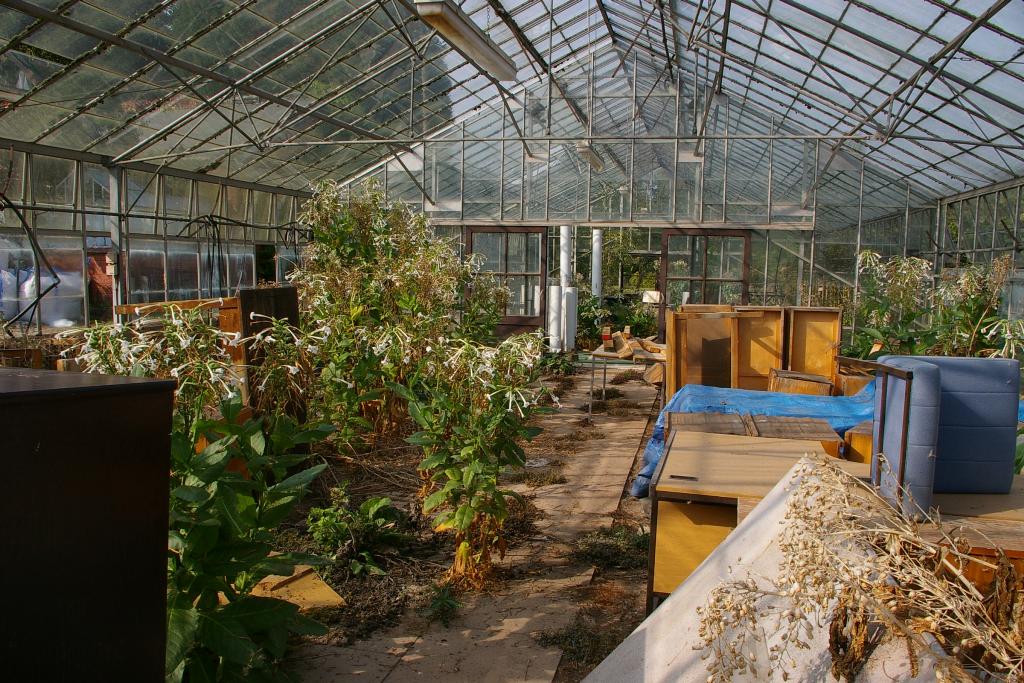
Nicotiana sylvestris or Argentine Tobacco growing ‘wild’ in a derelict glasshouse, Bham University Bot. Gardens, Winterbourne. (pictures by Mike Poulton)
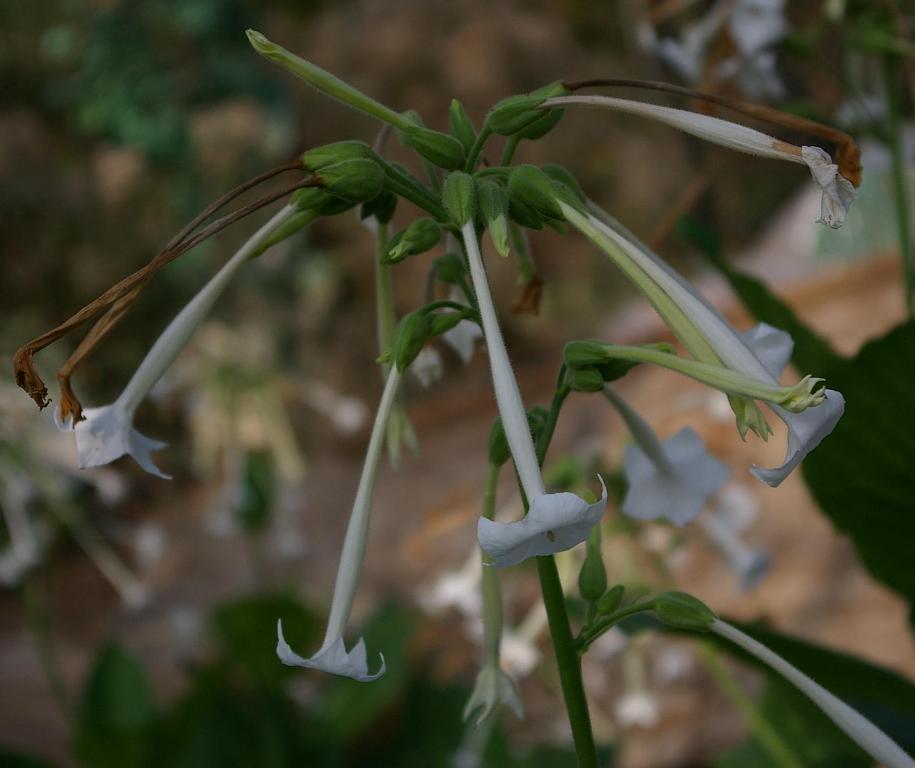
- N. sylvestris or Argentine Tobacco FBBC
Nicotiana sylvestris is cultivated as an ornamental plant. It is often planted in gardens for its architectural qualities and highly fragrant flowers. Though a short-lived perennial, in colder zones it is normally grown as a half-hardy annual, sown under glass with heat in early spring, and planted out after the last frosts. In Great Britain, it will only successfully overwinter in more sheltered coastal areas or parts of London where the temperature never falls below −5 °C (23 °F)
This plant has gained the Royal Horticultural Society‘s Award of Garden Merit.
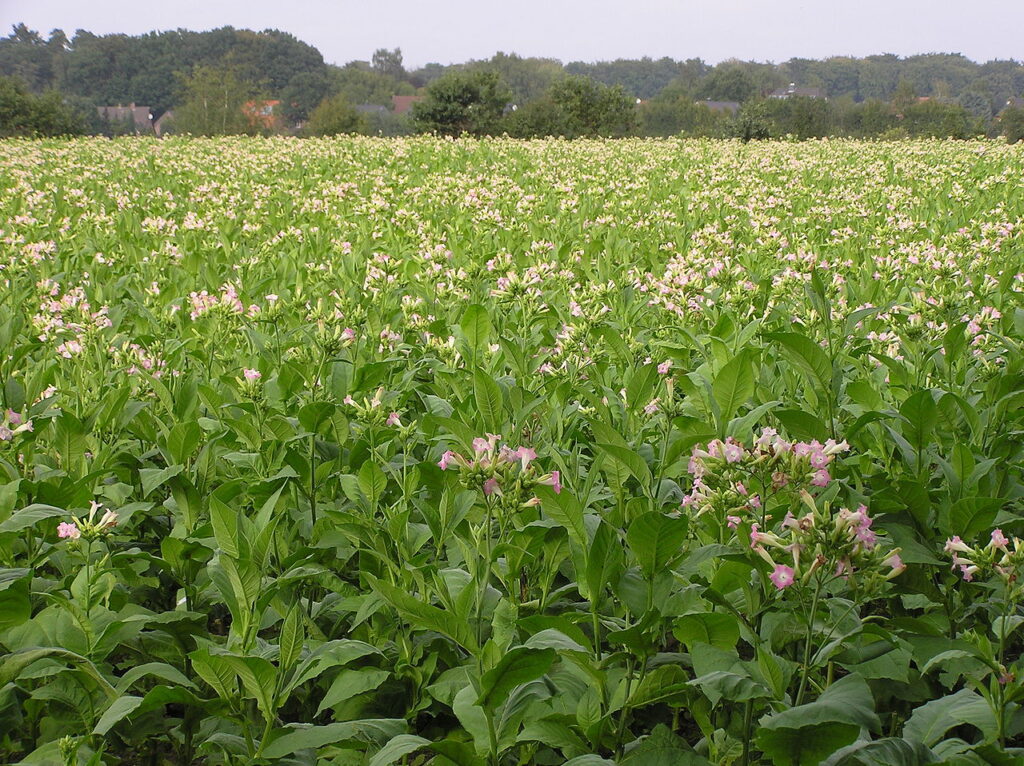
Nicotiana tabacum, or the cultivated tobacco, is an annually grown herbaceous plant of the Nicotiana genus. The plant is tropical in origin, is commonly grown throughout the world, and is often found in cultivation. It is the most commonly grown of all plants in the genus Nicotiana, the plants’ leaves commercially grown to be processed into tobacco. Tobacco has got a complex phytochemistry. Some other interesting uses for Tobacco found:
As Tobacco:
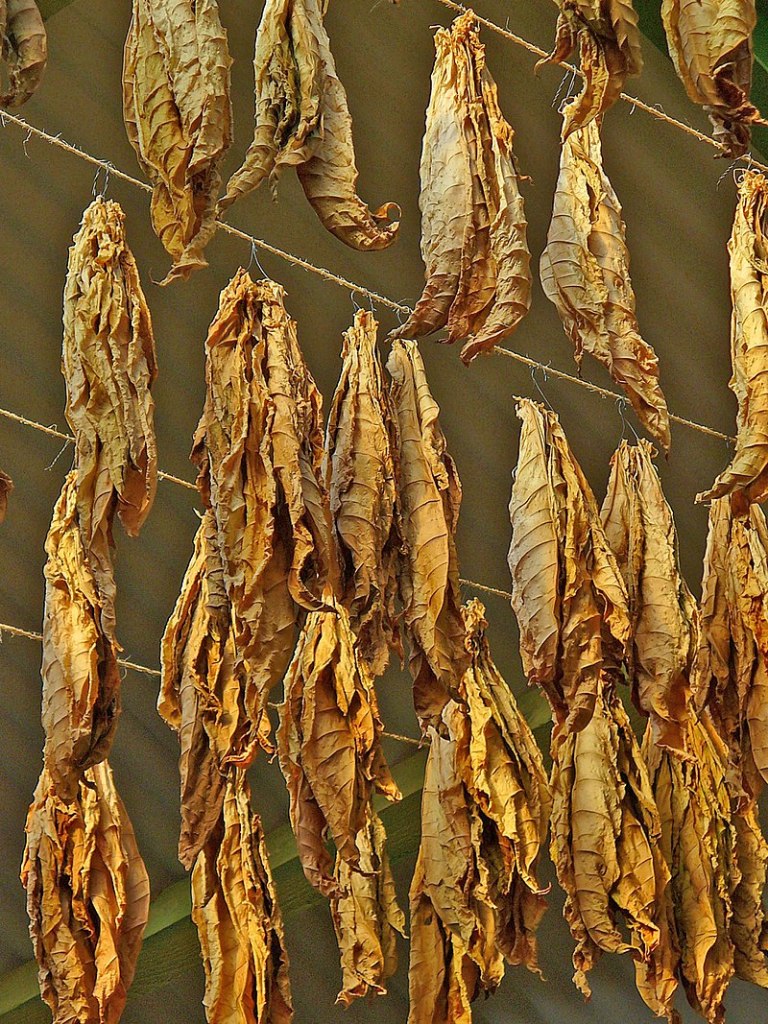
The plant should be used with great caution, when taken internally it is an addictive narcotic.
A protein can be extracted from the leaves. It is an odourless, tasteless white powder and can be added to cereal grains, vegetables, soft drinks and other foods. It can be whipped like egg whites, liquefied or gelled and can take on the flavour and texture of a variety of foods. It is 99.5% protein, contains no salt, fat or cholesterol. It was being tested in 1991 as a low calorie substitute for mayonnaise and whipped cream but no further information can be found by myself.
Tobacco has a long history of use by medical herbalists as a relaxant, though since it is a highly additive drug it is seldom employed internally or externally at present.
The leaves are antispasmodic, discutient, diuretic, emetic, expectorant, irritant, narcotic, sedative and sialagogue.
- They are used externally in the treatment of rheumatic swelling, skin diseases and scorpion stings.
- Wet tobacco leaves can be applied to stings in order to relieve the pain.
- They are also a certain cure for painful piles.
- A homeopathic remedy is made from the dried leaves.
- It is used in the treatment of nausea and travel sicknes.
Scientifically, it was the nineteenth-century model for understanding plant hybridisation, whilst during the twentieth century it was used to understand fundamental plant biology. In 1982, tobacco was the first artificially genetically modified plant.
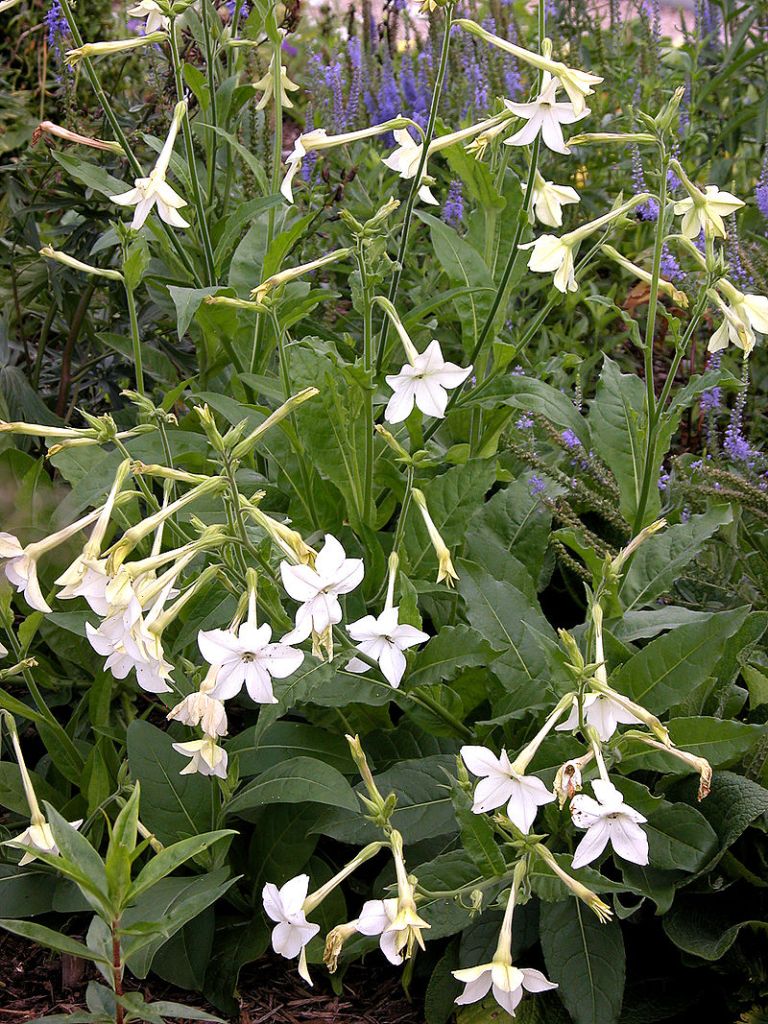
N. alata was first cultivated in Britain in 1829, and was recorded in the wild in 1912 (Hayes, West Kent). It is frequently cultivated for its scented flowers, and is surprisingly uncommon in the wild given its popularity with gardeners. This is the species from which most of the ornamental cultivars are derived, and hybrids with N. forgetiana (N. × sanderae) are common in gardens and may have been overlooked for this species.
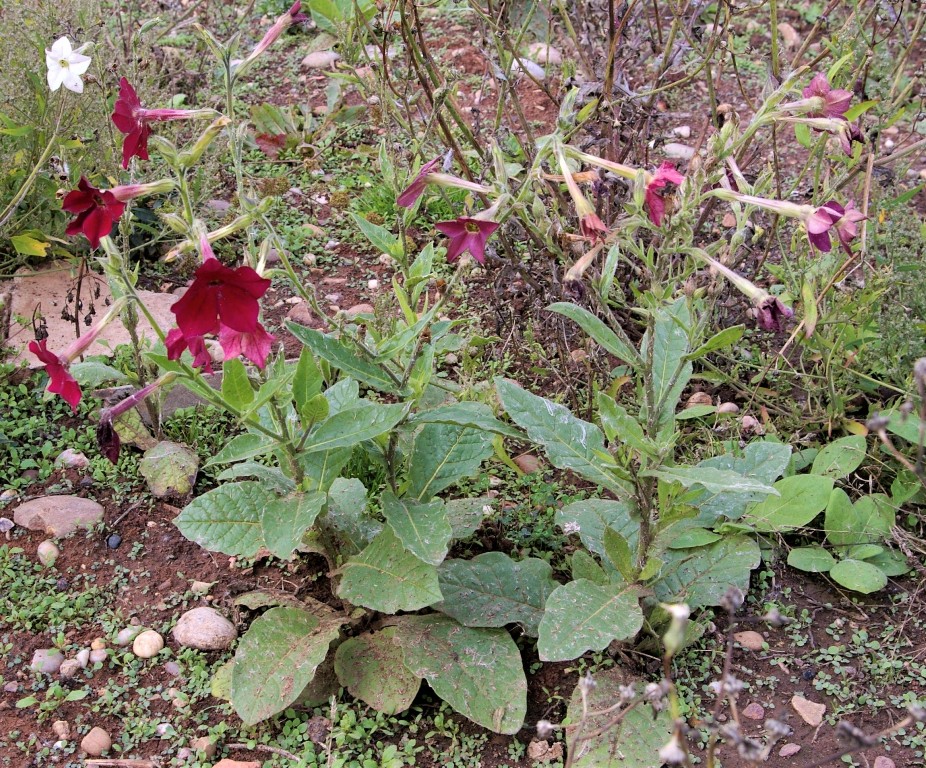
- N. x sanderea (N. alata × N. forgetiana) or Garden Tobacco FBBC
A partially hardy annual hybrid occurring as a garden escape on refuse tips, roadsides, landfill sites, old allotments and gardens, and waste ground.
N. × sanderae was raised in England by Messrs Sander & Sons of St Albans in 1903, and named by Watson (1904) from their material. It is often grown in gardens as a bedding plant, and was first recorded in the wild in 1965 (North Oxford tip, Oxfordshire). Though there has been an increase in records since 2000, it is probably still under-recorded, and overlooked for its parents, particularly N. alata.
This is the most common Nicotiana variety found and used as a garden ornamental plant. The plant comes in various colours, will grow to heights of 3 feet (0.91 m) and will give off a sweet scent in the evening.
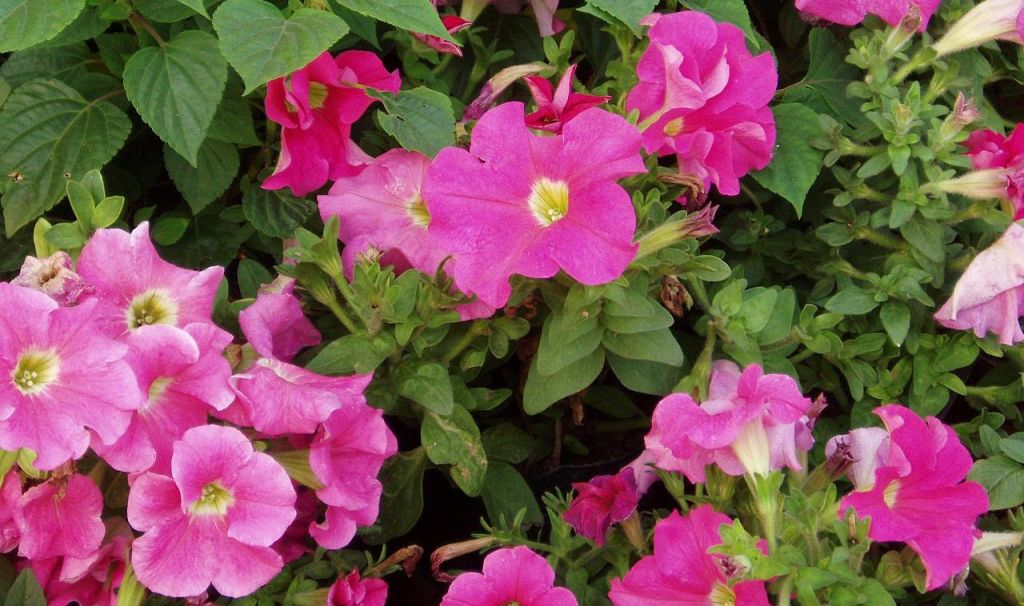
Petunia x hybrida (P. axillaris × P. integrifolia) or Petunia FBBC
A procumbent to erect annual hybrid, found as single plants, in small numbers, or occasionally in larger quantities on urban streetsides (where they often seed themselves from hanging baskets or window-boxes) and on dumped soil, disturbed roadsides, waste ground and refuse tips. It is usually casual, but sometimes persists for a few years. It is fertile, and sets abundant, but frost-sensitive, seed.
P. × hybrida was raised by 1837 and is extremely popular in cultivation. There were relatively few records pre-2000, and the considerable increase this century is most likely due to the fuller recording of aliens, coupled with a greater interest in recording urban flora. It was first recorded as a casual from Hanwell (Middlesex) in 1948.
